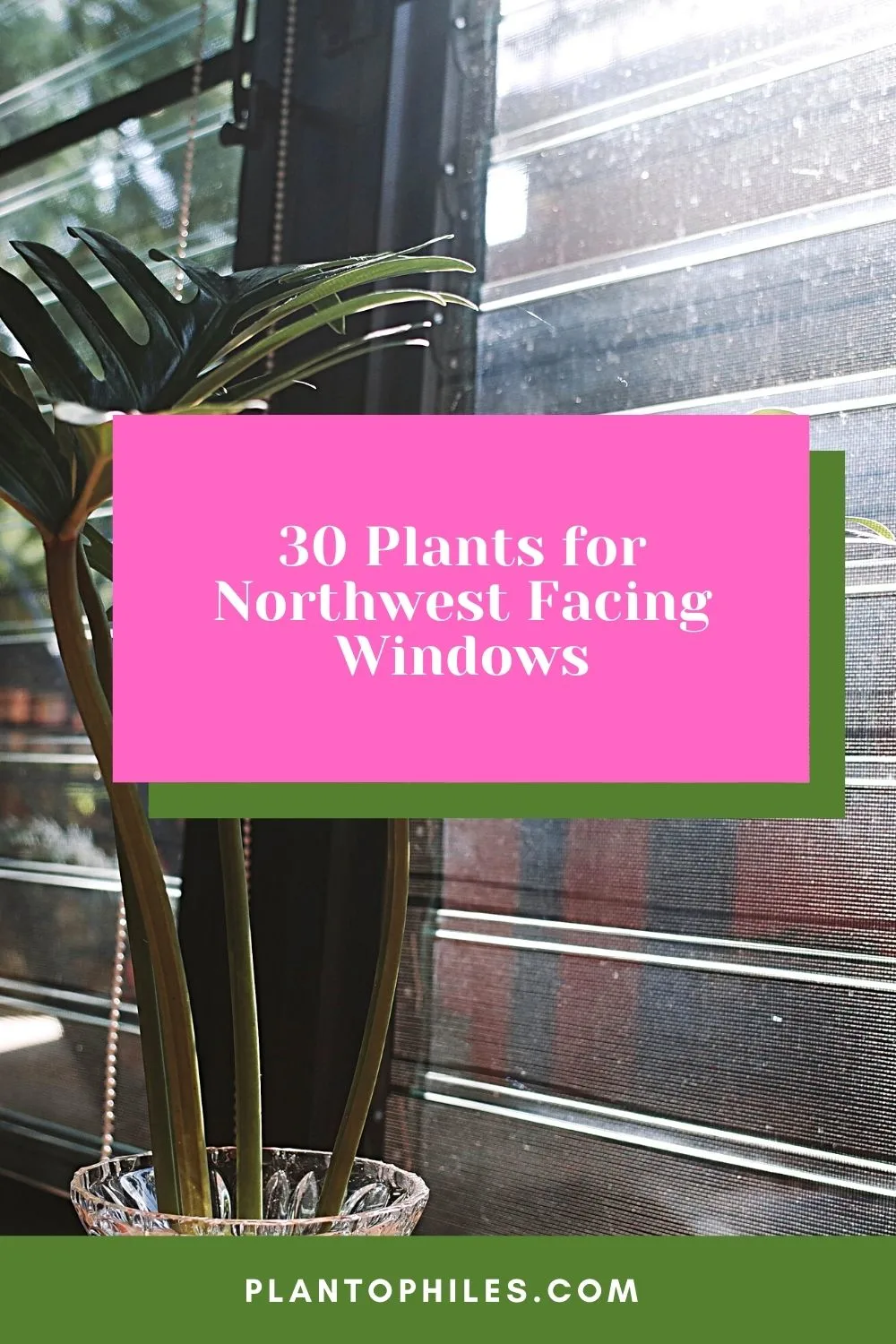When it comes to growing indoor plants, it’s all about the lighting.
You cannot change the orientation of your house or apartment, but you can definitely grow the plants that will thrive in the light levels of your house.
Northwest-facing windows will get the most light during the evening or afternoon in the summer season.
But what are the best plants for northwest-facing windows?
Most indoor gardeners believe that this orientation is best suited for plants that do not demand full or partial sunlight for the most part of the day.
If you place the plant right next to the window, it will receive almost 100% of the light, but if you move it a bit further into the room, the light intensity will reduce to 75%.
You can also keep some of the bright light-loving plants in the northern windows; the only issue you might face will be slower growth compared to a bright, well-lit area.
Variegated plants might lose some of the variegated patterns and colors in a low-light window.
Remember, plants with simple, dark-colored leaves do better under low light.
The plants might have leggy growth as they will try stretching towards the window to capture more light.
It’s best to rotate all plants growing in a northwest-facing window every few days.
30 Plants for Northwest Facing Windows
- Devil’s Ivy
- Chinese Evergreens
- Chinese Money Plant
- Umbrella Tree
- Nerve Plant
- Swiss Cheese Plant
- Baby Rubber Plant
- Snake Plant
- Fiddle Leaf Fig
- Birds of Paradise
- Heartleaf Philodendron
- Aluminum Plant
- Rubber Fig
- Spider Plant
- Happy Leaf Pothos
- Weeping Fig
- Peace Lily
- Painted Leaf Begonia
- Philodendron Imperial Red
- Cast Iron Plant
- Sanseviera Fernwood Mikado
- Prayer Plant
- English Ivy
- ZZ Plant
- Rattlesnake Plant
- Silver Pothos
- Kentia Palm
- Moth Orchid
- Hoya Wayetii
- Porcelain Flower
Table of Contents
Plants for Northwest Facing Windows
1. Devil’s Ivy
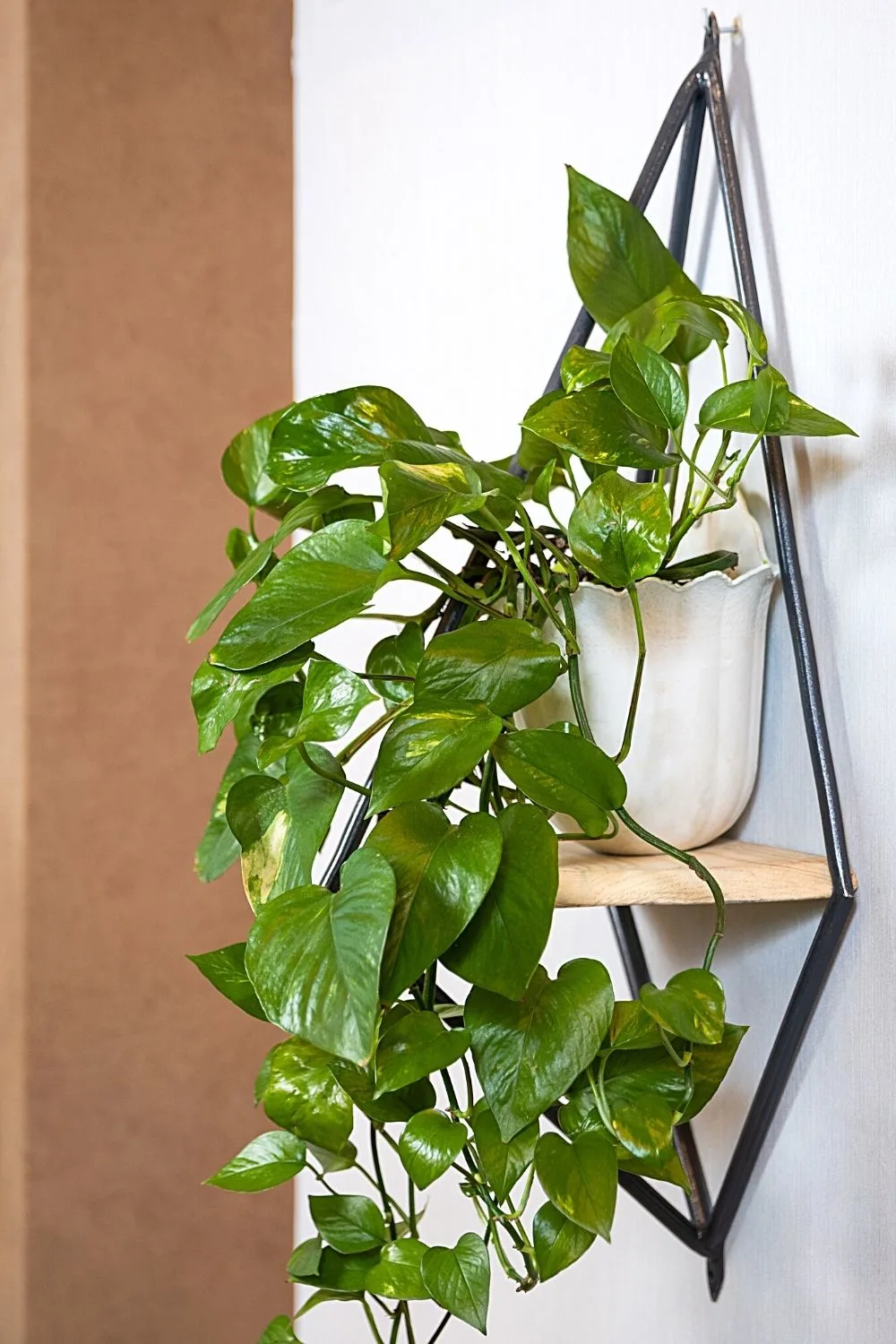
Devil’s Ivy is a beginner-friendly plant that you can place by your northwest-facing window
Devil’s Ivy belongs to the Pothos family, which is considered a beginner-friendly plant that thrives under a variety of growing conditions, including low to medium sunlight in a northwest-facing window.
This plant will add a touch of greenery to the dull areas of your house with its heart-shaped waxy leaves in shades of green and creamy yellow.
- Family: Araceae
- Scientific name: Epipremnum Aureum
- Toxicity: toxic for pets and humans
- Lighting: low to medium filtered sunlight
- Temperature: 61-84 degrees Fahrenheit (16-28 degrees Celsius)
- Soil: coco or peat moss soil mix
- pH: between 6.1 – 6.5
- Fertilizer: Every fortnight (2 weeks) during active growth and in the winter, only once monthly
- Growth rate: slow or fast-growing
- Humidity: loves high humidity but will survive under moderate humidity
2. Chinese Evergreens
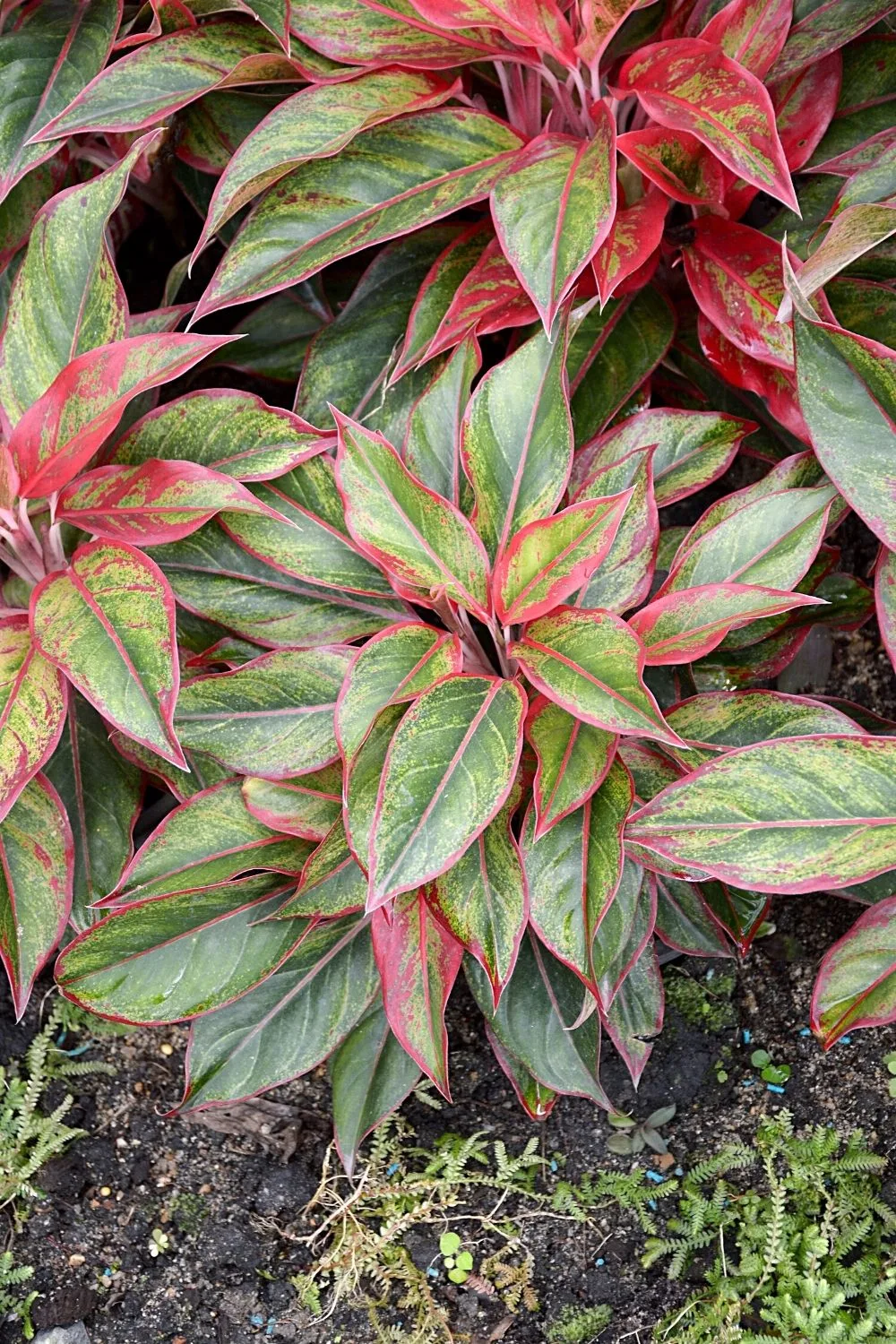
Chinese Evergreens is a popular plant to place by your northwest-facing window due to its air cleaning properties
Chinese Evergreens will bring a pop of green hues to your office or home windows. This good luck plant has several variants available in multiple shades and patterns.
The main reason it’s considered an easy indoor plant is because it has air cleaning properties and requires low light levels.
The long, pointy foliage is oval-shaped and grows on short stems giving it a bushy look.
Go for a darker-colored variant (e.g., Maria) as it will perform better under minimal light.
- Family: Araceae
- Scientific name: Aglaonema Commutatum
- Toxicity: Calcium oxalate crystals make it toxic for cats and dogs
- Lighting: low to bright light for at least 8-10 hours per day
- Temperature: 65-80 degrees Fahrenheit (18-26 degrees Celsius)
- Soil: a peat-based potting soil
- pH: between 5.5 – 6.5
- Fertilizer: Apply once monthly only in the growing season
- Growth rate: slow-growing
- Humidity: needs 60-70% humidity for best growth
3. Chinese Money Plant
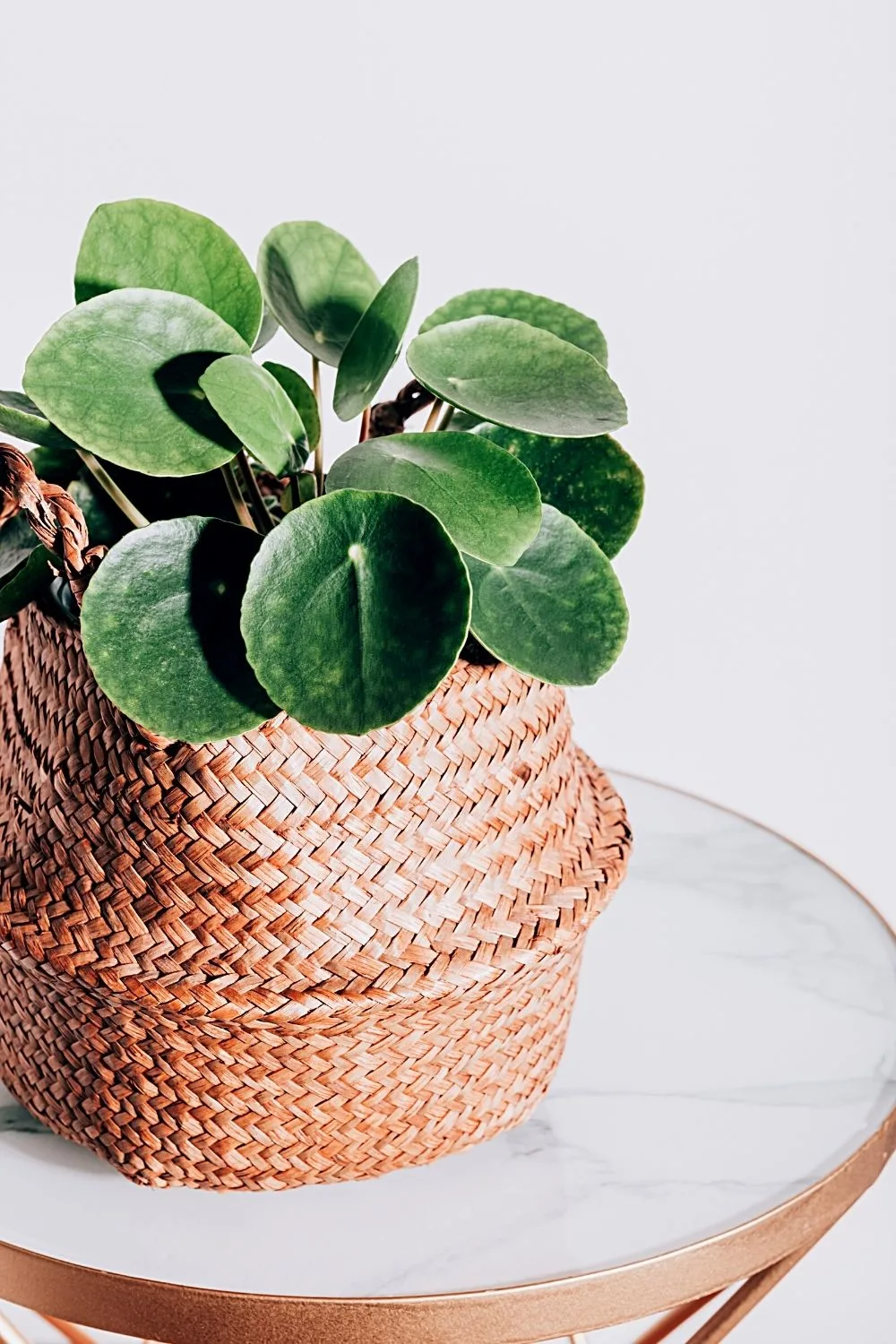
Chinese Money Plant can’t stand direct sunlight, hence, the light coming from a northwest-facing window is best for it
This is one of my favorite houseplants with its simple green disc-like round leaves.
This flowering perennial is native to China and has several names, including the Pancake plant and the Coin plant.
This plant will never tolerate direct sunlight as it will burn and scar the beautiful leaves; therefore, a northwest-facing window is the right indoor spot where it receives indirect sunlight only.
- Family: Urticaceae or the Nettle family
- Scientific name: Pilea Peperomioides
- Toxicity: non-toxic for pets and humans
- Lighting: at least 4 hours of bright but indirect light
- Temperature: 55-86 degrees Fahrenheit (13-30 degrees Celsius)
- Soil: coco coir or peat-based potting soil with perlite
- pH: between 6.0 – 7.0
- Fertilizer: light feeding once monthly during summer and spring
- Growth rate: fast-growing
- Humidity: loves high humidity
4. Umbrella Tree
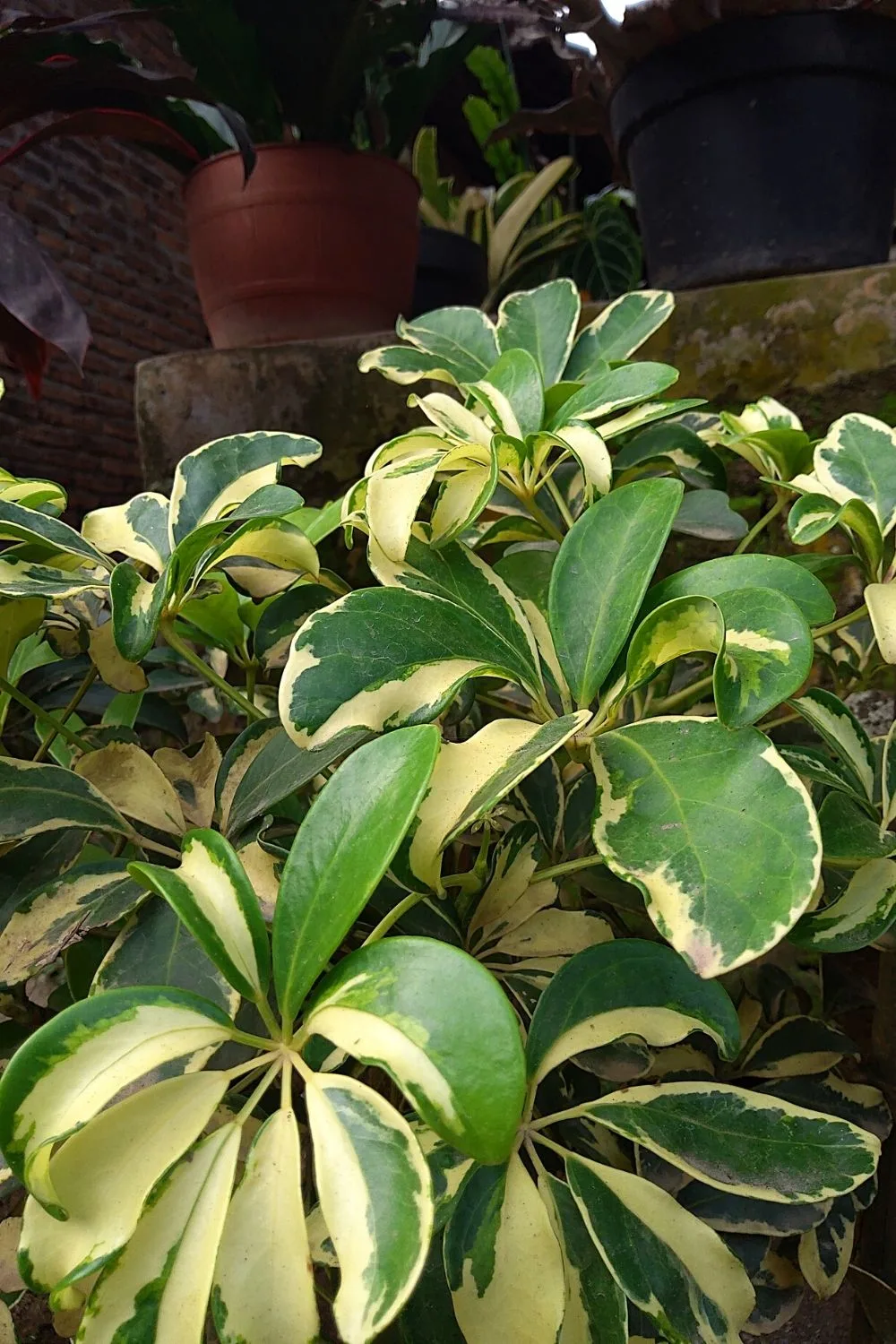
Umbrella Tree, with its long, oval leaves, is another beautiful plant to grace your northwest-facing window
Each stalk on this plant has a cluster of leaves, giving it a look resembling an umbrella.
These long, oval leaves are solid green or variegated with a glossy touch. Once this plant matures, it looks like a dwarf tree and looks lovely in any corner of the room.
Make sure you prune the foliage regularly for a fuller look.
This plant is native to Australia and South Asian countries, and it has become a trendy houseplant in the category of tall indoor plants. The dwarf Umbrella Tree reaches 4 feet as a maximum height.
- Family: Araliaceae
- Scientific name: Schefflera Arboricola
- Toxicity: All plant parts are toxic to pets and humans
- Lighting: medium or filtered light for at least 4 hours
- Temperature: 55-75 degrees Fahrenheit (13-24 degrees Celsius)
- Soil: Sandy, loamy soil with excellent drainage
- pH: acidic, between 6.0 – 6.5
- Fertilizer: Feed twice weekly in summer and spring using liquid plant food
- Growth rate: slow growers when planted in a pot
- Humidity: higher than 70%
5. Nerve Plant
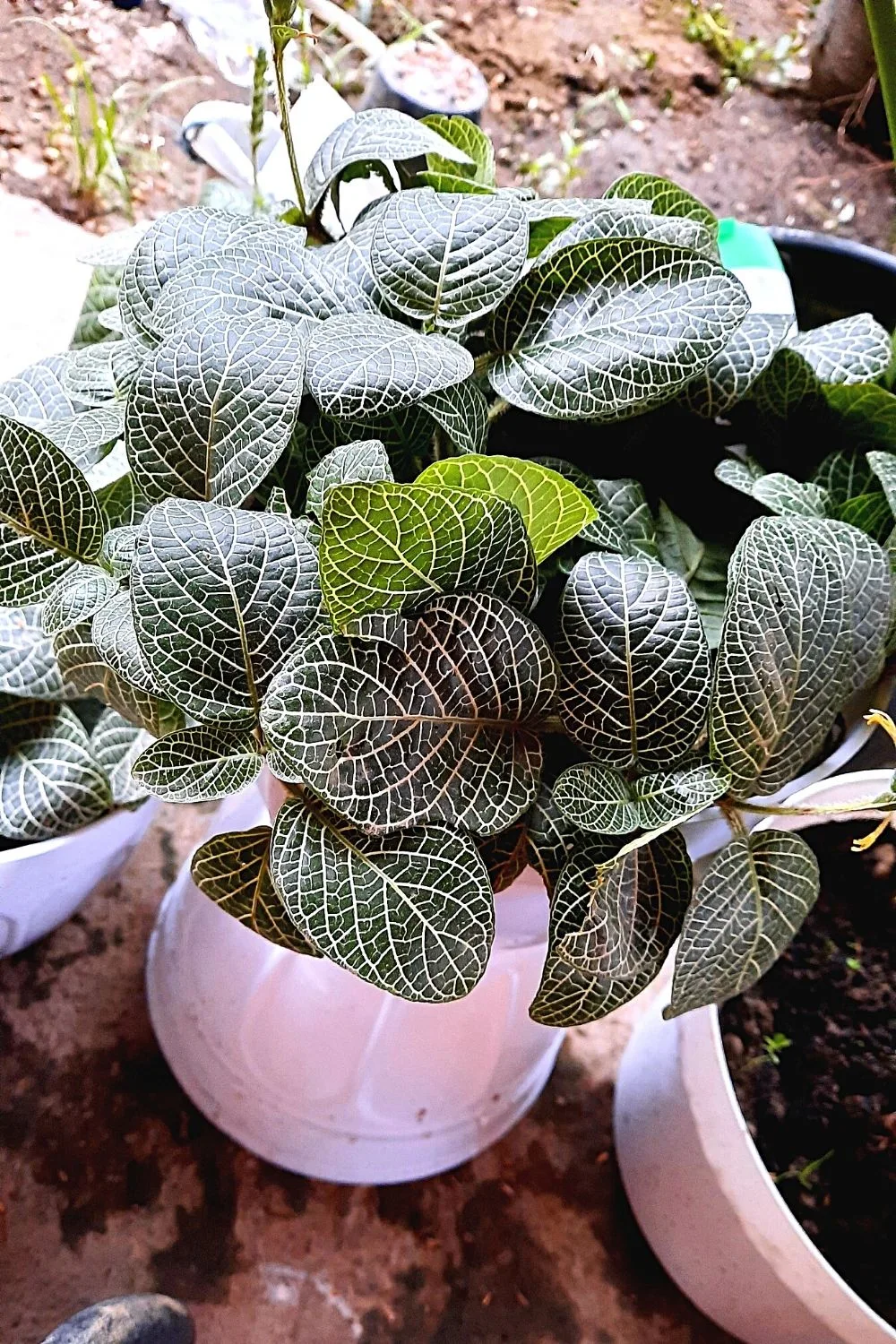
Aka the Mosaic Plant, you can place the Nerve Plant by your northwest-facing window
This curious-looking plant has delicate veins with deep green leaves, giving it the name Mosaic plant. Hence, if you find your Nerve Plant’s leaves curling, investigate for the cause straight away.
This is a creeping variety, so it reaches a maximum height of 3-6 inches only. The silvery-white variant is the most common one, but you can also find variants in other bright colors like red, pink, etc.
One thing to remember about this variety is that it is highly sensitive to direct sunlight.
- Family: Acanthaceae
- Scientific name: Fittonia Albivenis
- Toxicity: nontoxic and safe to be around pets and children
- Lighting: partially shaded spot or indirect sunlight
- Temperature: 60-79 degrees Fahrenheit (15-25 degrees Celsius)
- Soil: peat-based soil mix with good water retention and drainage properties
- pH: close to 6.5
- Fertilizer: use liquid fertilizer once weekly during its growing months
- Growth rate: slow-growing indoor plants
- Humidity: regularly high humidity
6. Swiss Cheese Plant
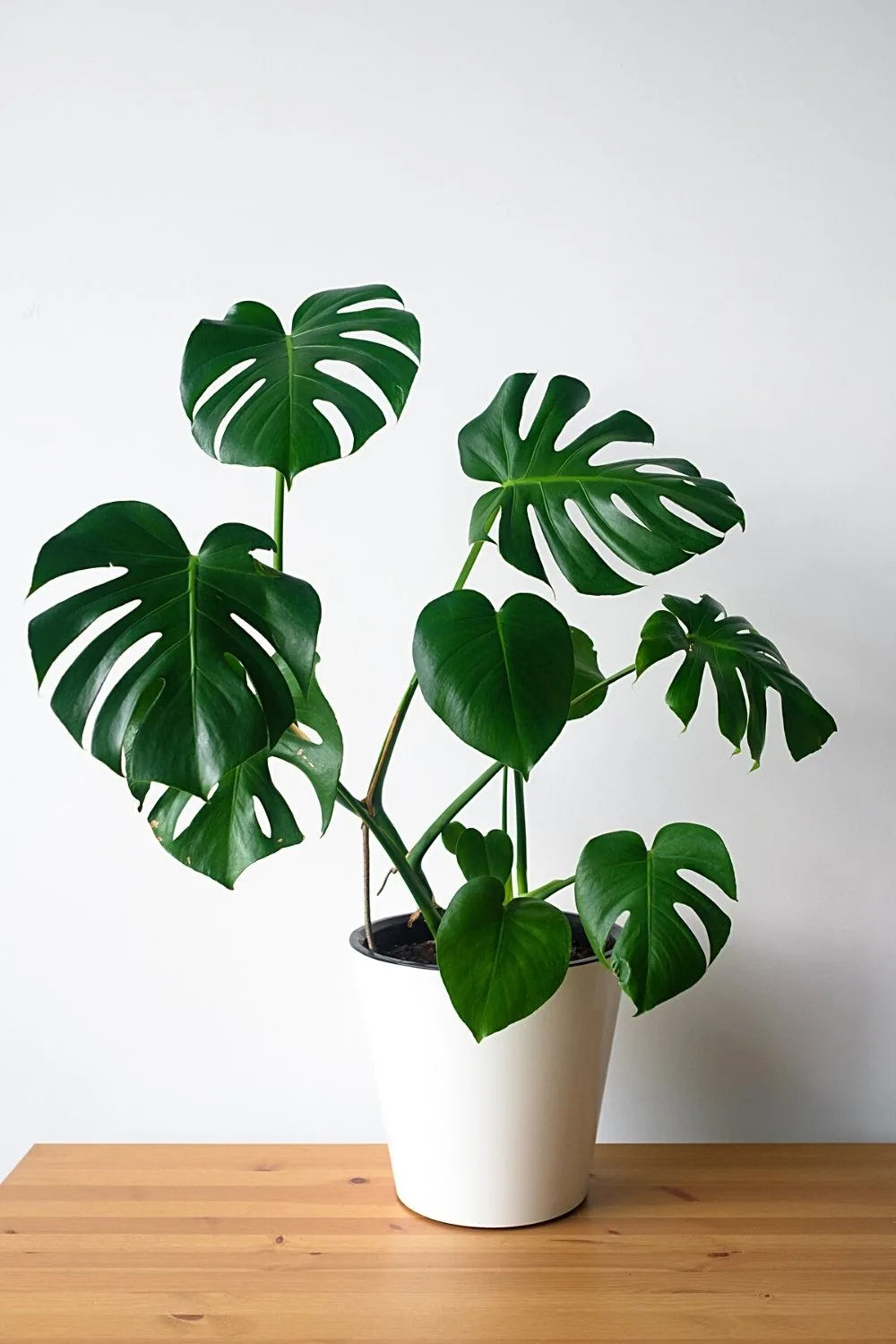
Swiss Cheese Plant has an easy-to-care-for schedule that helps when you place it by your northwest-facing window
This plant is a must-have for every corner of your house.
The large, heart-shaped foliage and fenestrations are always a great addition to an easy-care schedule for Monstera.
- Family: Araceae
- Scientific name: Monstera Deliciosa
- Toxicity: All parts are toxic for pets and children
- Lighting: bright, filtered sunlight (5-8 hours)
- Temperature: 65-84 degrees Fahrenheit (18-28 degrees Celsius)
- Soil: peat-based soil mixture
- pH: between 5.5 – 7
- Fertilizer: Once monthly, use a complete fertilizer
- Growth rate: Moderate
- Humidity: at least 50%
7. Baby Rubber Plant
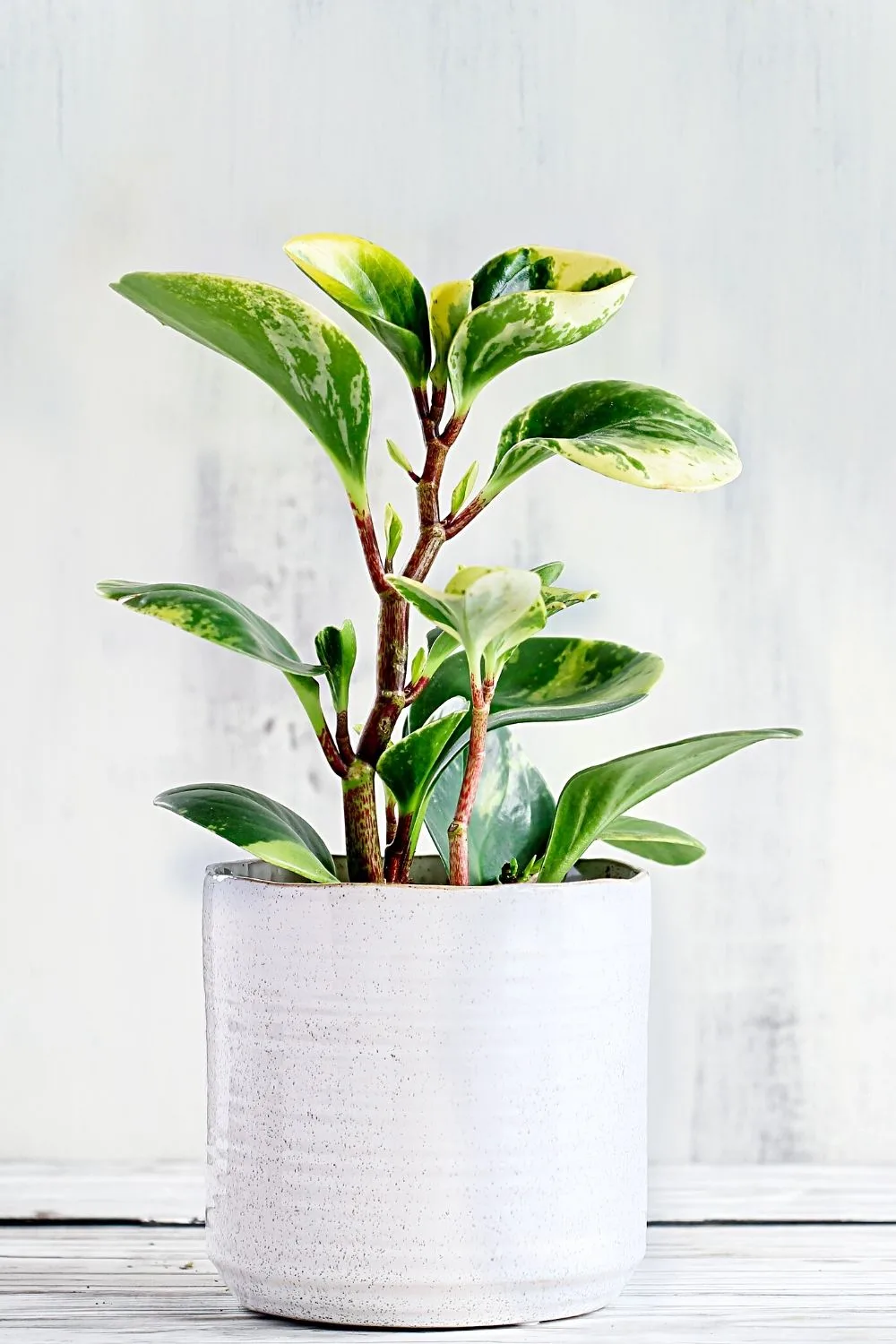
Baby Rubber Plant has thick upright stalks that looks great by your northwest-facing window
The most attractive feature of this plant is the bushy foliage with oval-shaped glossy, succulent leaves.
This Peperomia also has thick, upright stalks. The succulent foliage will store water; therefore, water your plant carefully, especially when placed under low light.
This South American native will reach a maximum size of 11 inches as an indoor houseplant.
- Family: Piperaceae
- Scientific name: Peperomia Obtusifolia
- Toxicity: non-toxic for pets
- Lighting: needs medium to bright sunlight but also grows under low light
- Temperature: 65-74 degrees Fahrenheit (18-23 degrees Celsius)
- Soil: peat-based soil with perlite and sand
- pH: between 5.5 – 7.0
- Fertilizer: feed it once or twice a month in spring and summer using liquid fertilizers
- Growth rate: fast-growing variety
- Humidity: at least 40-50%
8. Snake Plant
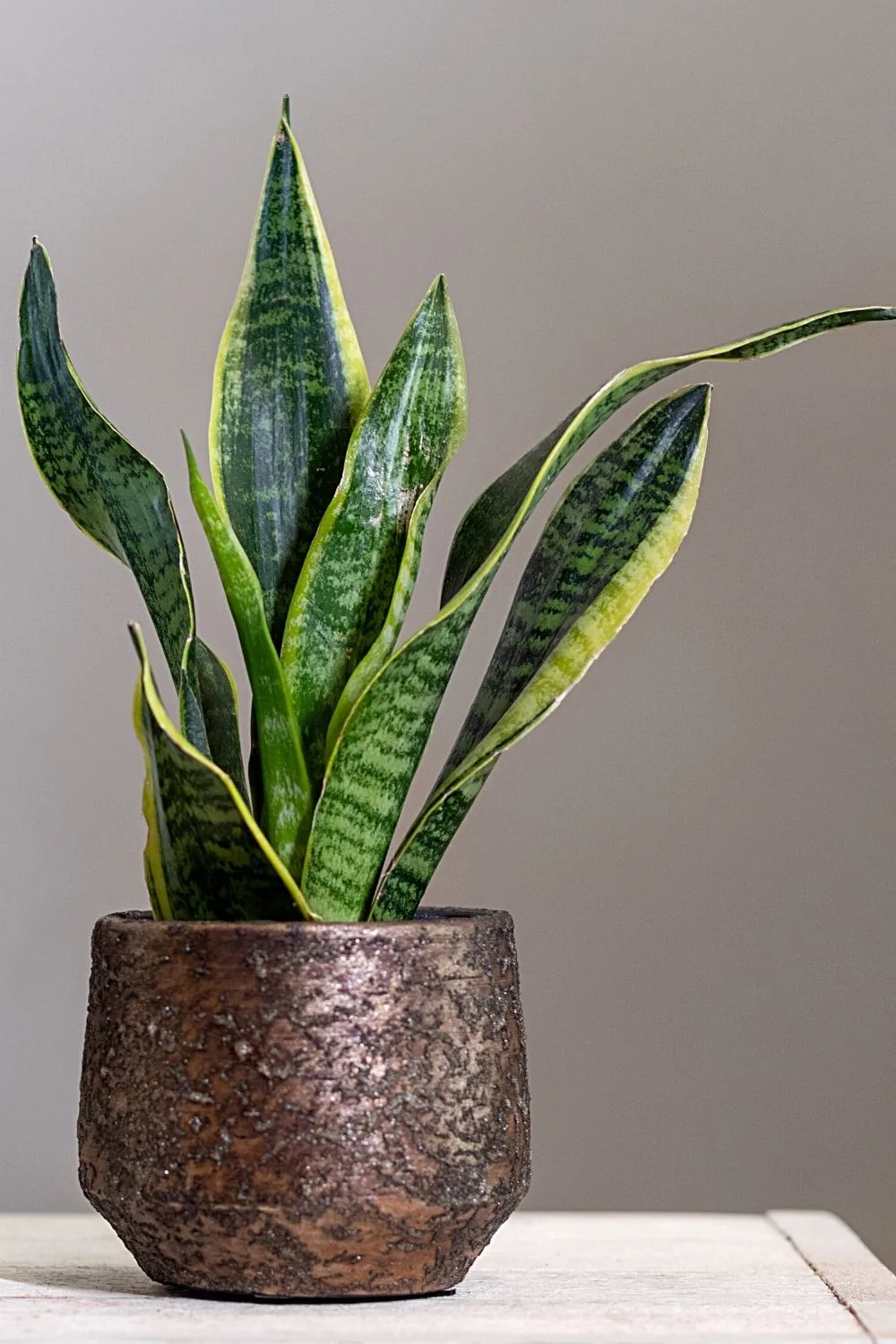
Snake Plant is another easy-to-care-for plant to be placed by your northwest-facing window
This plant features stiff, pointy leaves that vary in shades of yellow, green, and white variegation.
The snake plant is one of the plants that are easiest for new owners to care for since it’s impossible to kill.
This is one of the hardy houseplants that will thrive in a dark corner of your house.
- Family: Asparagaceae
- Scientific name: Dracaena Trifasciata
- Toxicity: not pet friendly
- Lighting: prefers filtered but steady light throughout the day
- Temperature: 70-90 degrees Fahrenheit (21-32 degrees Celsius)
- Soil: sandy soil with good drainage
- pH: 6.0 to 6.5
- Fertilizer: apply a succulent and cactus fertilizer during its growing months
- Growth rate: slow-growing under low light
- Humidity: around 40% or higher for better growth
9. Fiddle Leaf Fig
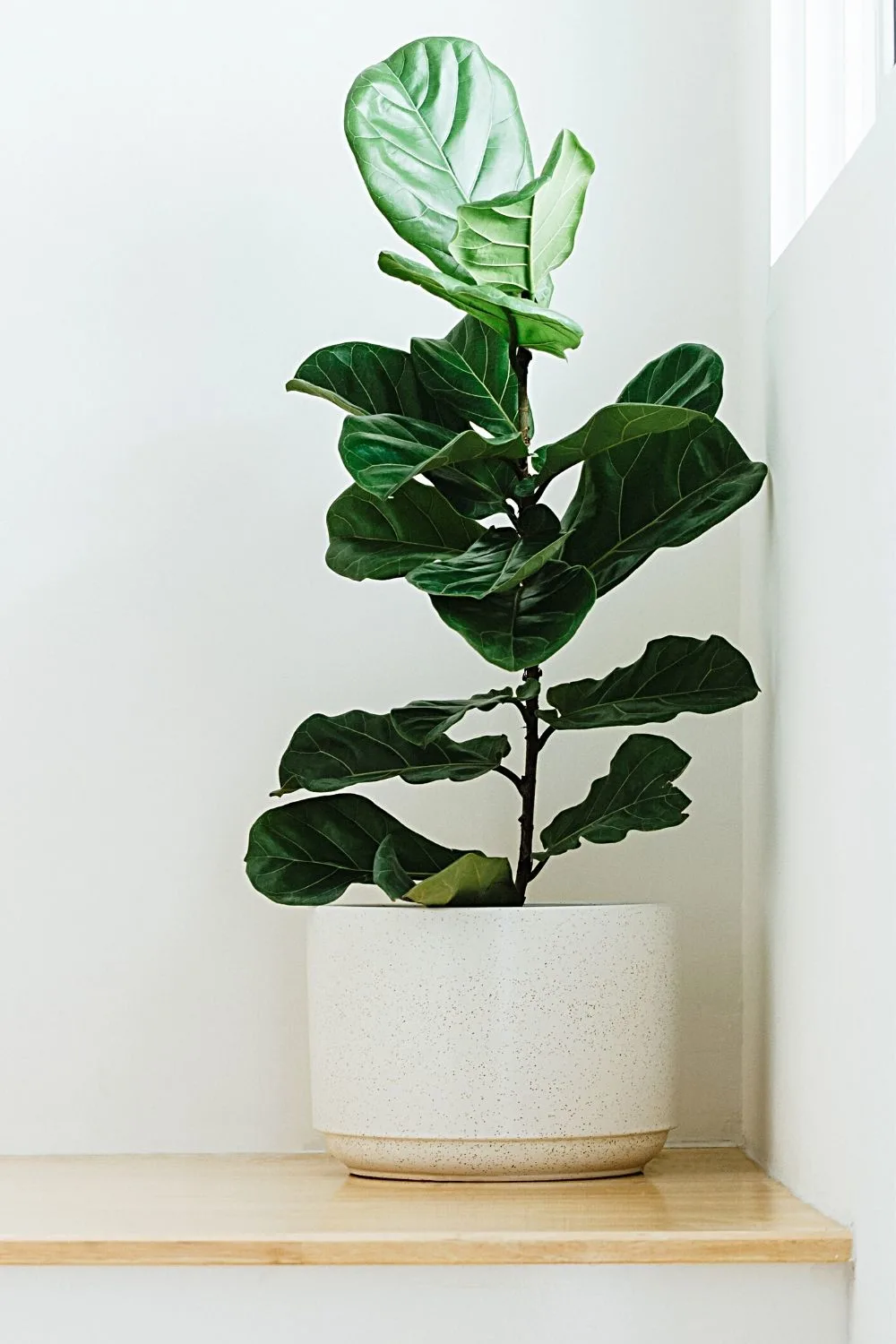
You can place grow lights over your Fiddle Leaf Fig even when you place them by a northwest-facing window
The bottle green leaves of the Fiddle Leaf Fig, a broadleaf evergreen, have a shiny finish.
These leaves have wavy edges and prominent white veins on the leaf surface.
You can add grow lights above this plant if you want your Fiddle Leaf Fig to reach its maximum growth potential.
- Family: Moraceae
- Scientific name: Ficus Lyrata
- Toxicity: toxic for both cats and dogs
- Lighting: tolerates low light conditions
- Temperature: 60-74 degrees Fahrenheit (15-23 degrees Celsius)
- Soil: well-draining loamy soil
- pH: between 6.0 – 7.0
- Fertilizer: regularly feed with a nitrogen-based fertilizer during the growing season
- Growth rate: fast-growing
- Humidity: 30 – 65 %
10. Birds of Paradise
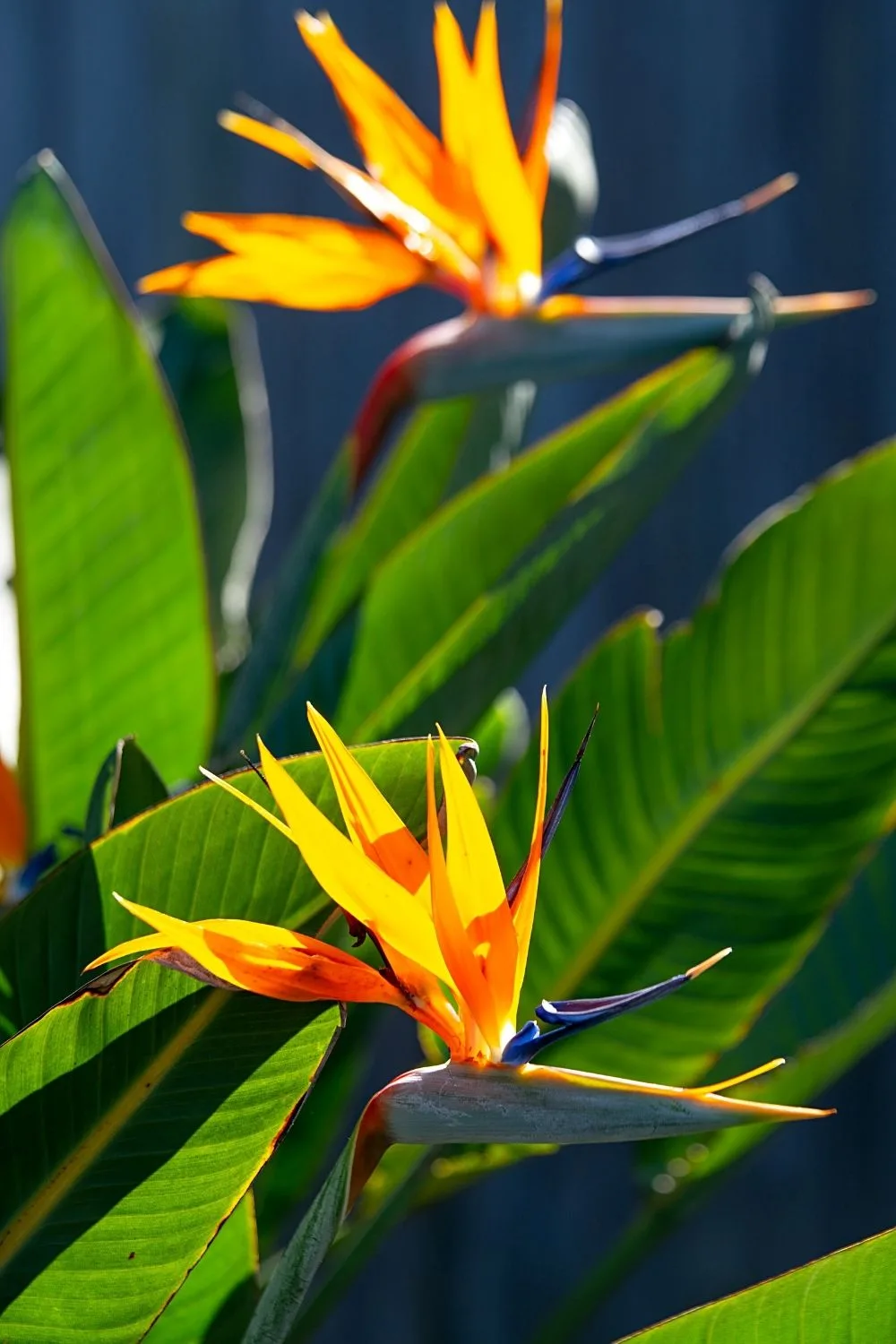
A good ornamental plant to place by your northwest-facing window is the Birds of Paradise plant
This ornamental plant is named after its exotic orange flowers. The leaves resemble the foliage of a banana plant.
You might not experience the flowers when growing them indoors, but you can definitely enjoy the lush green foliage.
- Family: Strelitziaceae
- Scientific name: Strelitzia Reginae
- Toxicity: poisonous for pets
- Lighting: adapts to low light levels but will also grow under bright light
- Temperature: 65-84 degrees Fahrenheit (18-29 degrees Celsius)
- Soil: Combination of peat moss, perlite, and lava rocks
- pH: between 5.5 – 7.5
- Fertilizer: Feed once every week in spring and summer with liquid fertilizer
- Growth rate: fast-growing houseplant
- Humidity: 50% or higher
11. Heartleaf Philodendron
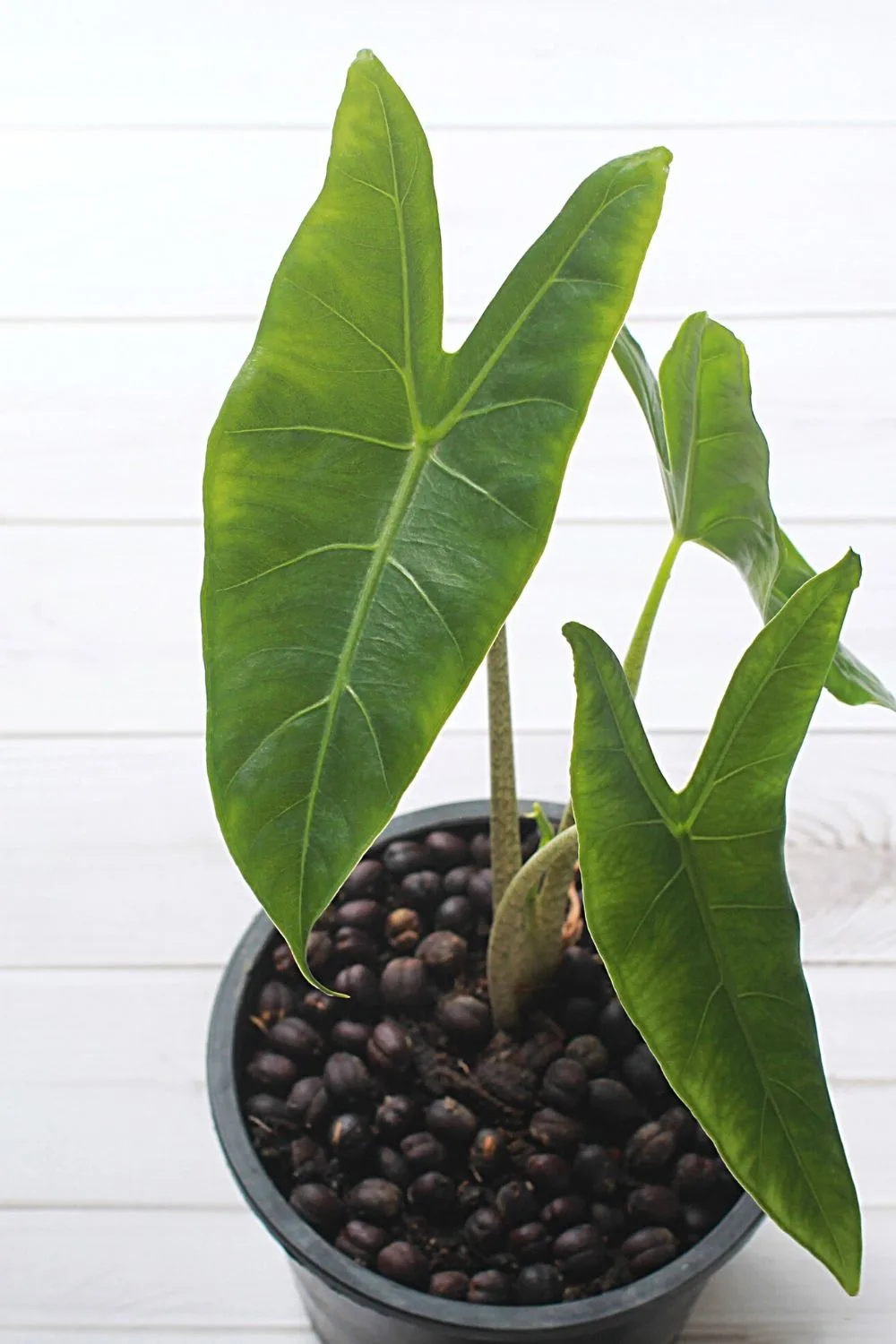
You’ll have to keep pruning your Heartleaf Philodendron to avoid it overrunning your northwest-facing window
The bright green, heart-shaped leaves of this plant make it perfect for your tabletops, window sill, and hanging pots.
Initially, the leaves are bronze but turn dark green as the plant matures.
This tropical perennial will grow about 4 ft long vines. You will have to regularly perform pruning to keep this plant under control.
- Family: Araceae
- Scientific name: Philodendron Hederaceum
- Toxicity: calcium oxalate crystals make it toxic for human and animal consumption
- Lighting: Moderate to bright, indirect light
- Temperature: 18-21 degrees Celsius (65-75 degrees Fahrenheit)
- Soil: a lightweight soil mixture rich in organic matter
- pH: between 6.0 – 7.0
- Fertilizer: add diluted liquid plant food once or twice in the growing season
- Growth rate: fast-growing
- Humidity: at least 40%
12. The Aluminum Plant
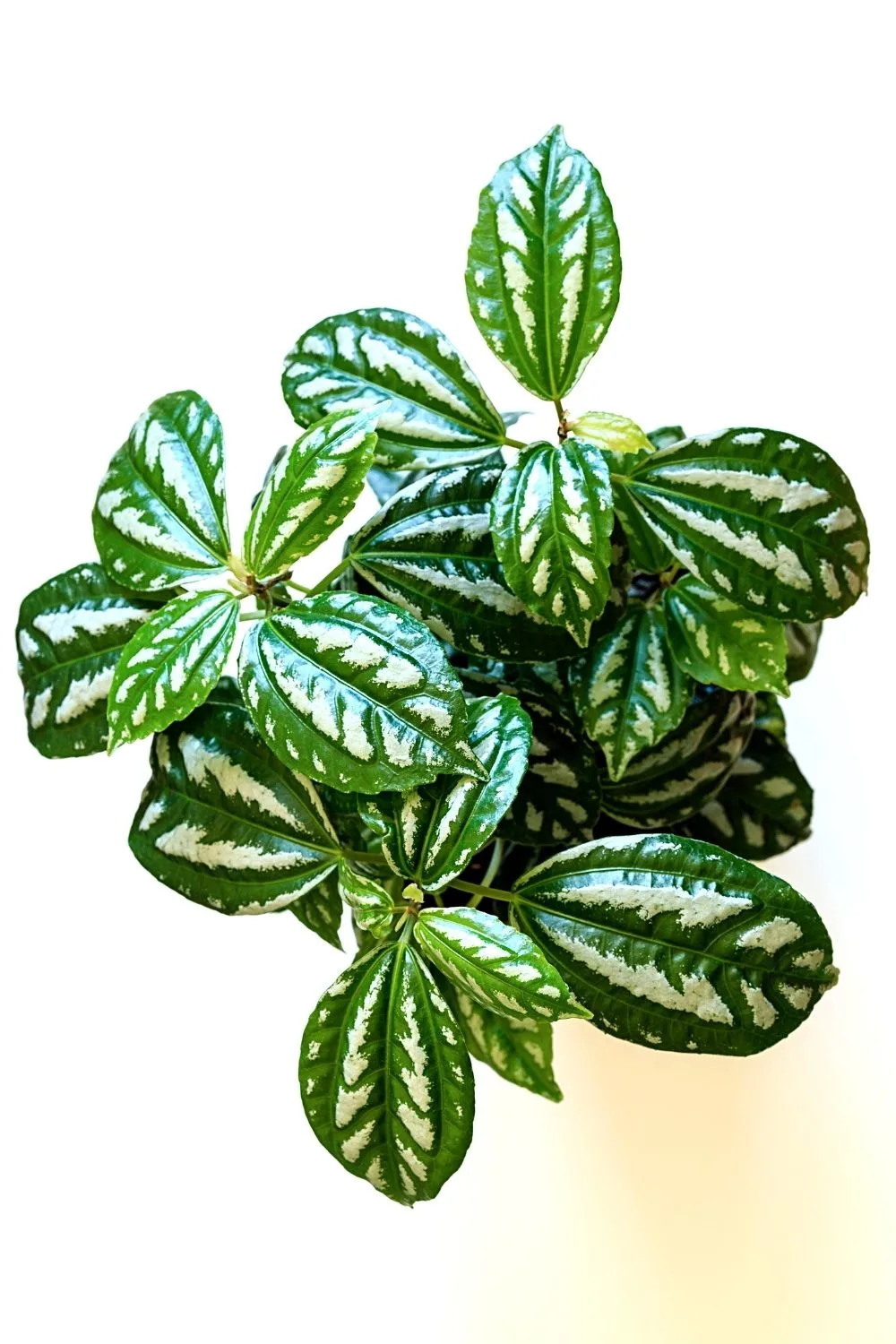
The silver leaves of the Aluminum Plant are a great way to beautify your northwest-facing window
The bright green leaves of this plant have a light-colored pattern giving it a sophisticated look.
The silver patterns give a unique look to this plant, and it’s a compact variety (maximum height is 12 inches).
The dwarf version of this plant, known as Minima, reaches an optimum height of 4 inches only.
- Family: Urticaceae
- Scientific name: Pilea Cadierei
- Toxicity: non-toxic to pets
- Lighting: needs bright, filtered sunlight for at least 4 hours
- Temperature: 60-74 degrees Fahrenheit(15-23 degrees Celsius)
- Soil: well-draining sandy soil mixture
- pH: between 5.0 – 6.0
- Fertilizer: add a balanced fertilizer once monthly in its growing season
- Growth rate: fast grower
- Humidity: higher than 60%
13. Rubber Fig
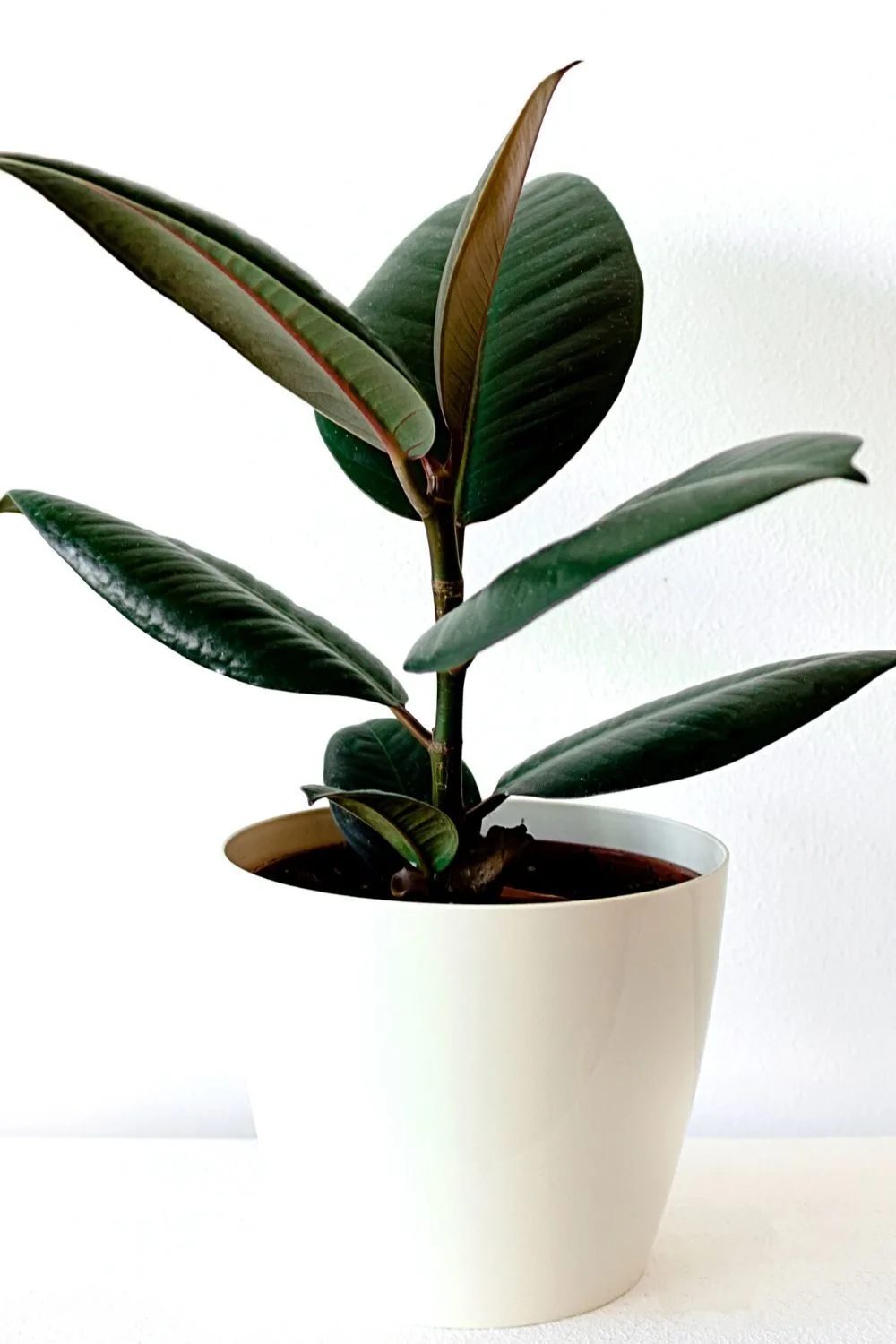
Rubber Fig is a low-maintenance tropical plant that you can place by your northwest-facing window
This modern version of the rubber plant has thick, green leaves with a reddish-brown petiole.
The tropical foliage of this low-maintenance plant has air purifying properties when planted indoors.
- Family: Moraceae
- Scientific name: Ficus Elastica Robusta
- Toxicity: contains latex in the plant sap
- Lighting: adapts to lower and bright light conditions
- Temperature: 60-74 degrees Fahrenheit (15-23 degrees Celsius)
- Soil: a combination of peat, pine bark, and sand
- pH: between 5.5 – 7.0
- Fertilizer: Apply a light fertilizer during the growing season
- Growth rate: fast-growing variety
- Humidity: no specific air moisture requirements
14. Spider Plant
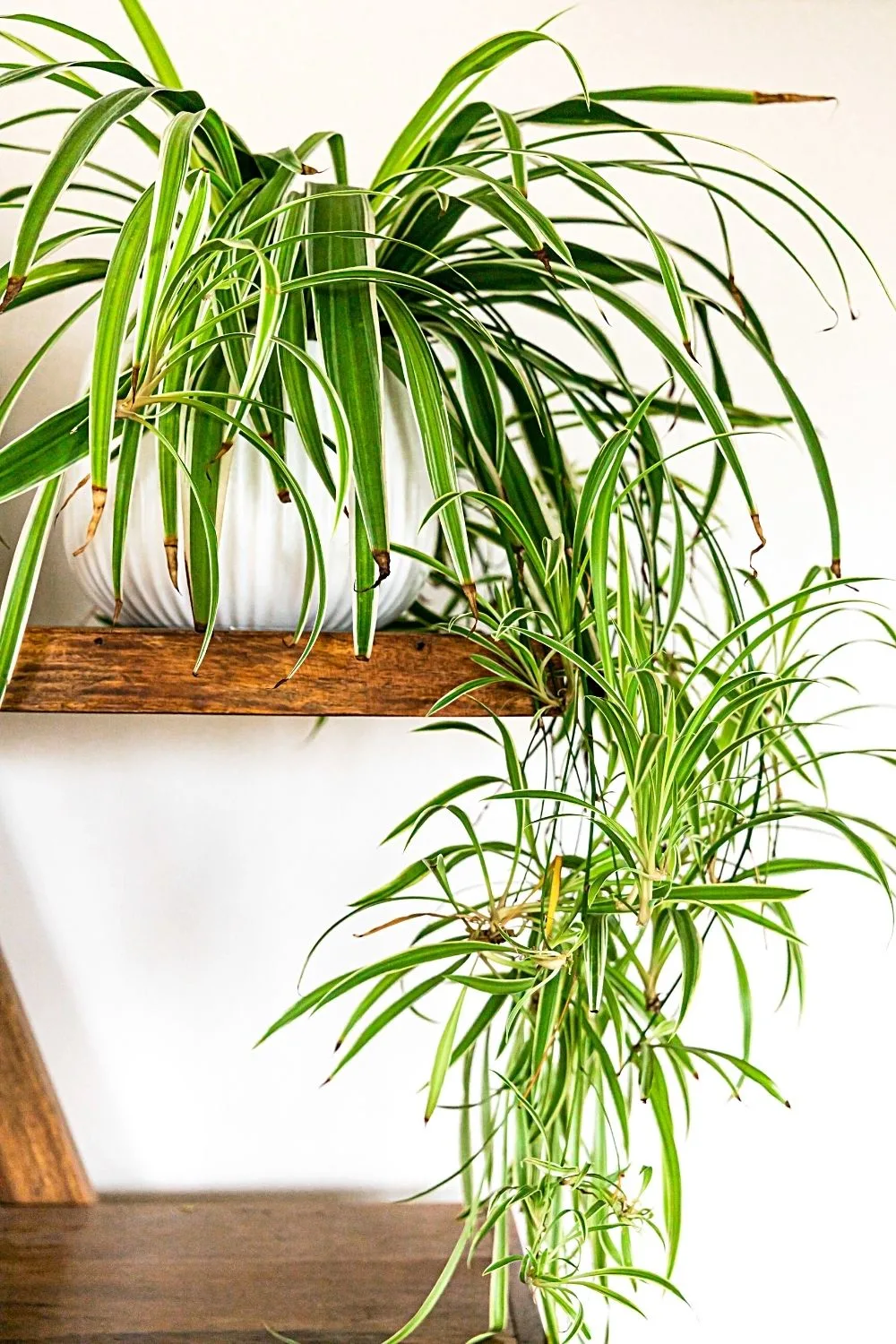
Spider Plant is one of the easiest hanging plants that you can grow indoors, preferably by a northwest-facing window
The spider plant, a known perennial, is one of the easiest hanging plants for indoor gardening.
It grows a cluster of slender, pointed leaves that vary in length between 12-18 inches. Mature plants will also bloom and showcase white flowers.
- Family: Asparagaceae
- Scientific name: Chlorophytum Comosum
- Toxicity: non-toxic for cats and dogs
- Lighting: partial shade or bright filtered light
- Temperature: 55 to 80 degrees Fahrenheit (13 to 26 degrees Celsius)
- Soil: Loose, loamy soil mixture with good drainage properties
- pH: between 6.0 – 6.5
- Fertilizer: once monthly in the summer and spring season
- Growth rate: moderate to fast growth
- Humidity: 60 % or above
15. Happy Leaf Pothos
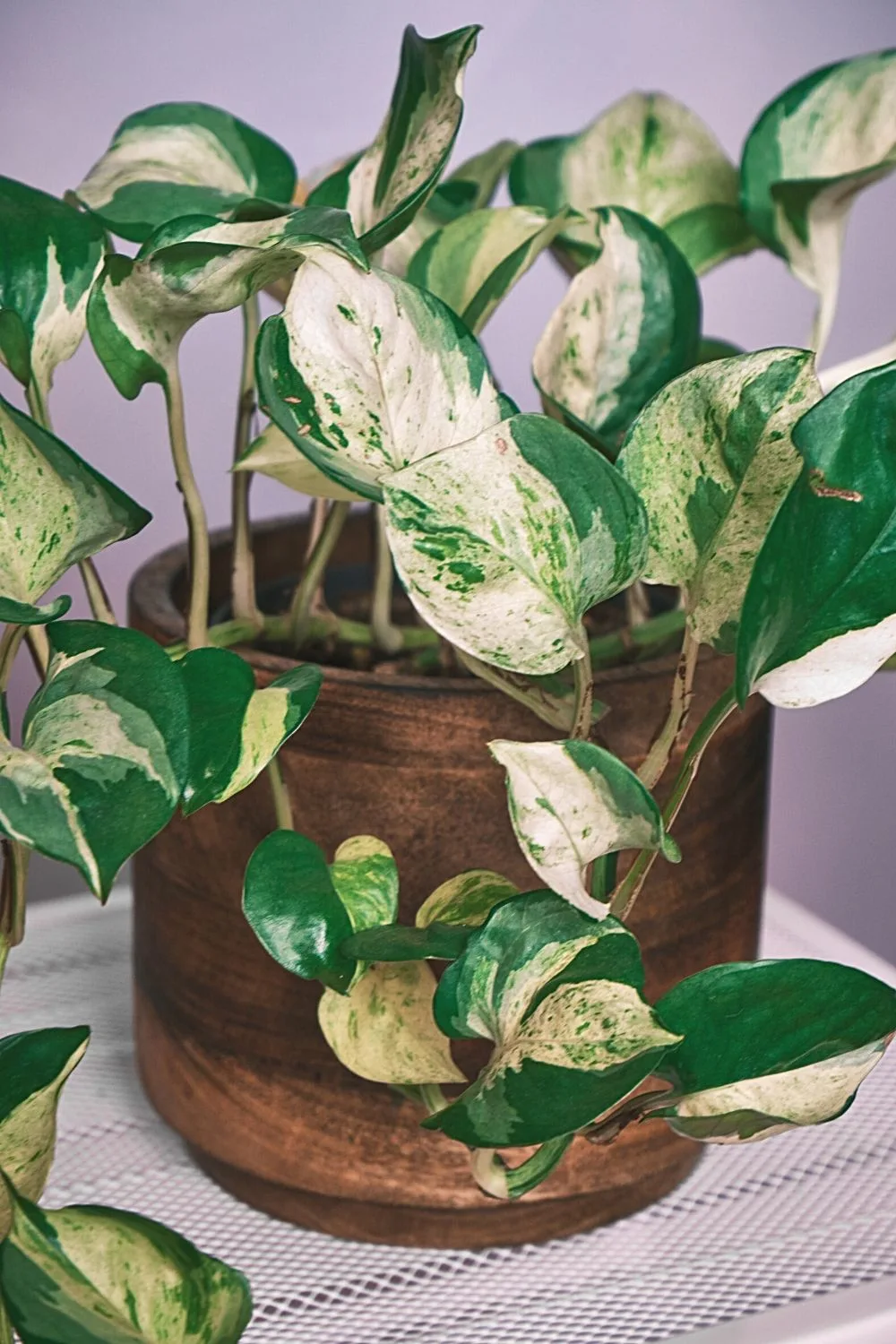
The climbing variety of the Happy Leaf Pothos is an easy plant for beginners to take care of and place by a northwest-facing window
The variegated creamy yellow and green leaves, as well as the spikey white flowers of the Happy Leaf Pothos, aka Manjula Pothos, help it stand out among other regular houseplants.
This climbing variety is easy to care for houseplant for beginners.
- Family: Araceae
- Scientific name: Epipremnum Aureum Happy
- Toxicity: poisonous for humans and pets
- Lighting: low to medium sunlight
- Temperature: 60-79 degrees Fahrenheit (15-25 degrees Celsius)
- Soil: Peat based mixture amended with perlite
- pH: between 6.0 – 6.5
- Fertilizer: does not require regular feeding
- Growth rate: moderate
- Humidity: at least 40%
16. Weeping Fig
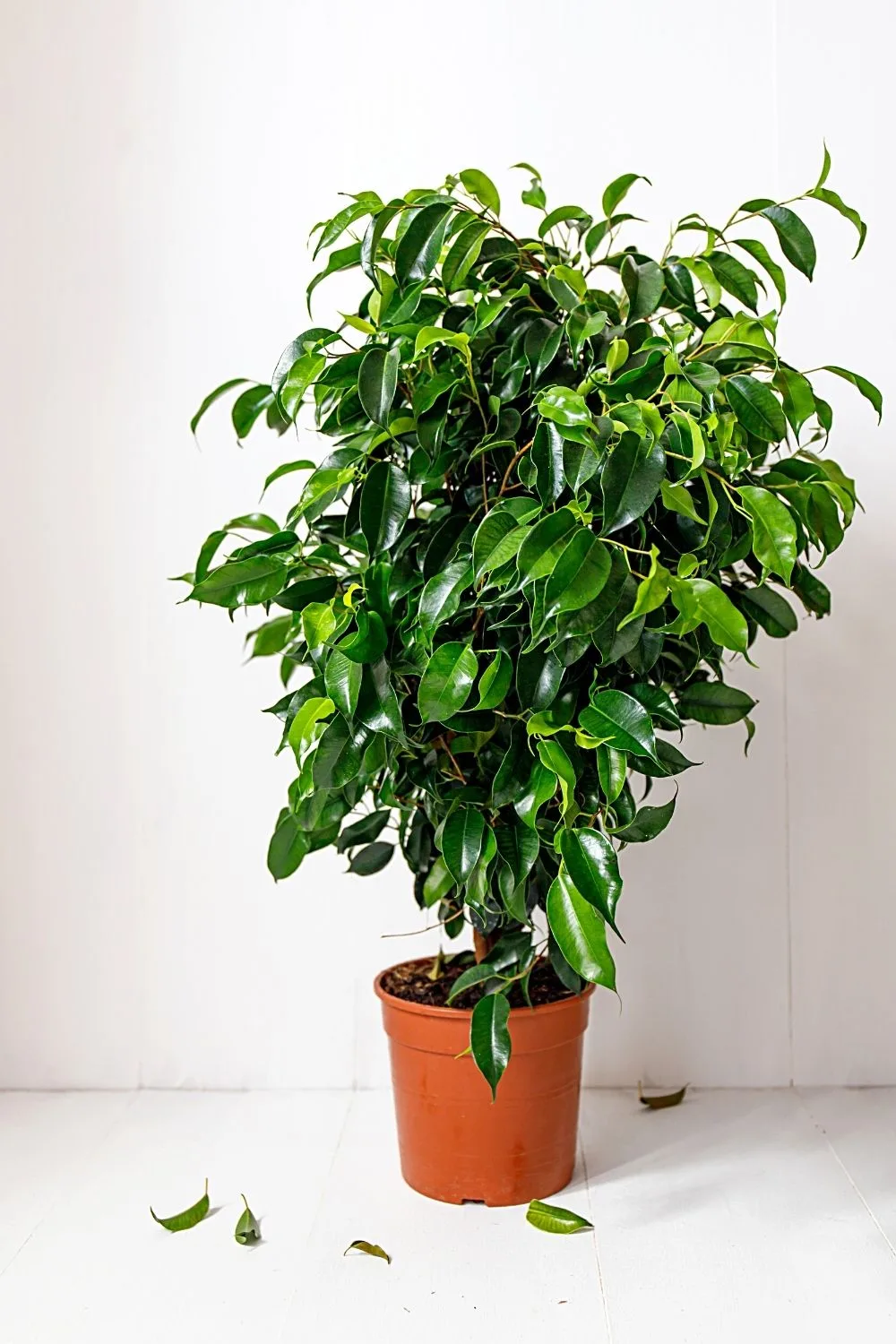
Weeping Fig is another beautiful plant that you can place by your northwest-facing window
The glossy green leaves of the Ficus tree compliment the light gray trunk of this plant.
It’s a popular choice for decorating indoor spaces like apartments, offices, and lobbies, where it reaches a maximum size of 6 ft.
- Family: Moraceae
- Scientific name: Ficus Benjamina
- Toxicity: toxic for animals and pets
- Lighting: semi-shaded spots with filtered bright sunlight
- Temperature: 66-85 degrees Fahrenheit (19-29 degrees Celsius)
- Soil: potting soil combined with perlite and sand
- pH: between 6.0 – 6.5
- Fertilizer: heavy feeders need fertilizer every month during the growing seasons
- Growth rate: fast grower
- Humidity: 50-70%
17. Peace Lily
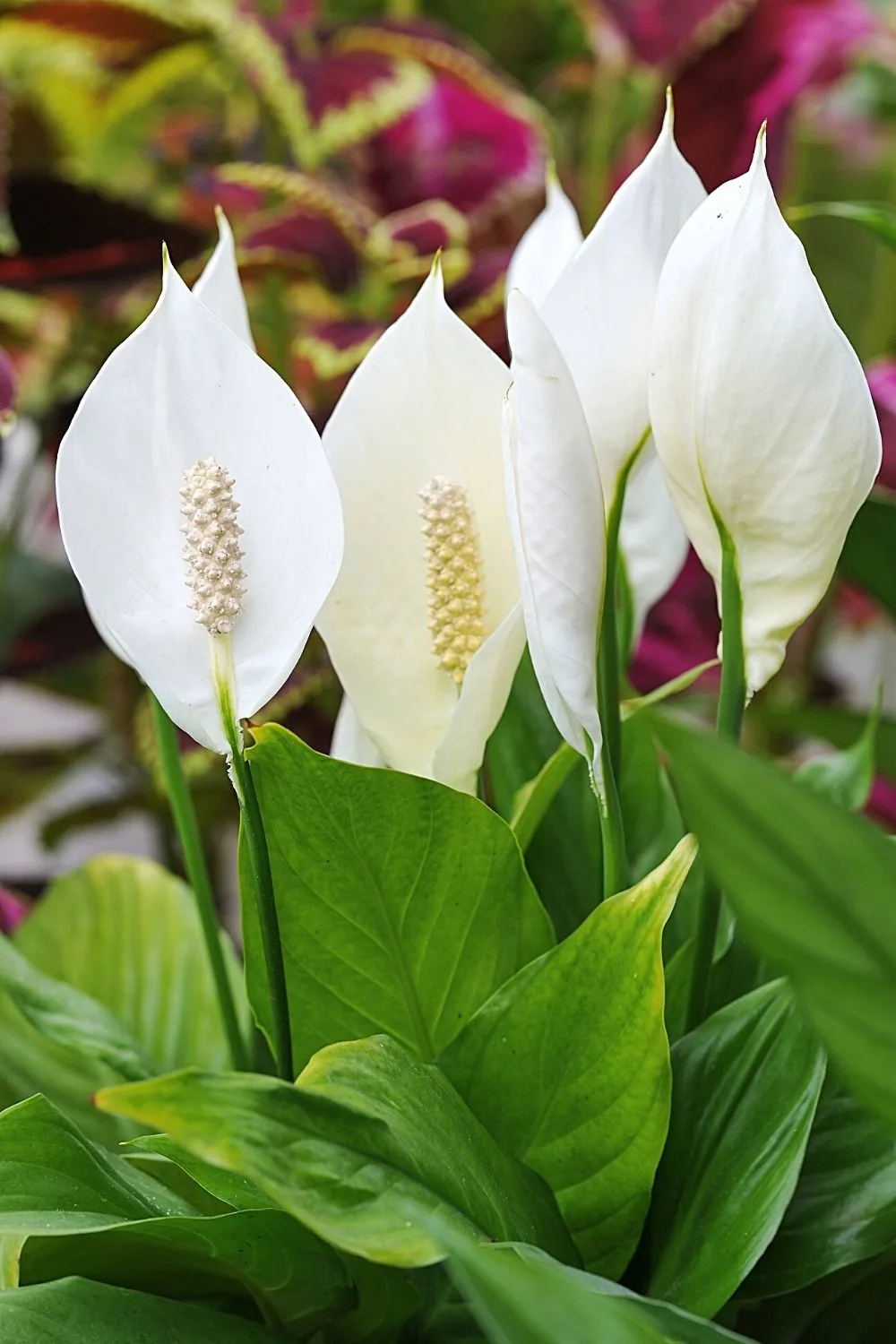
Peace Lily is an elegant plant that helps to clean the air toxins by your northwest-facing window
This elegant plant will decorate your house and cleanse the air from harmful toxins. The dark-colored foliage will grow well under low light conditions.
Peace Lilies show off beautiful white flowers in the summer season.
- Family: Araceae
- Scientific name: Spathiphyllum
- Toxicity: mildly toxic
- Lighting: low to medium light
- Temperature: 60-70 degrees Fahrenheit (16-21 degrees Celsius)
- Soil: homemade soil using perlite, peat moss, and coco coir
- pH: between 5.8 – 6.5
- Fertilizer: feed only one or two times per year
- Growth rate: moderate
- Humidity: enjoy high humidity
18. Painted Leaf Begonia
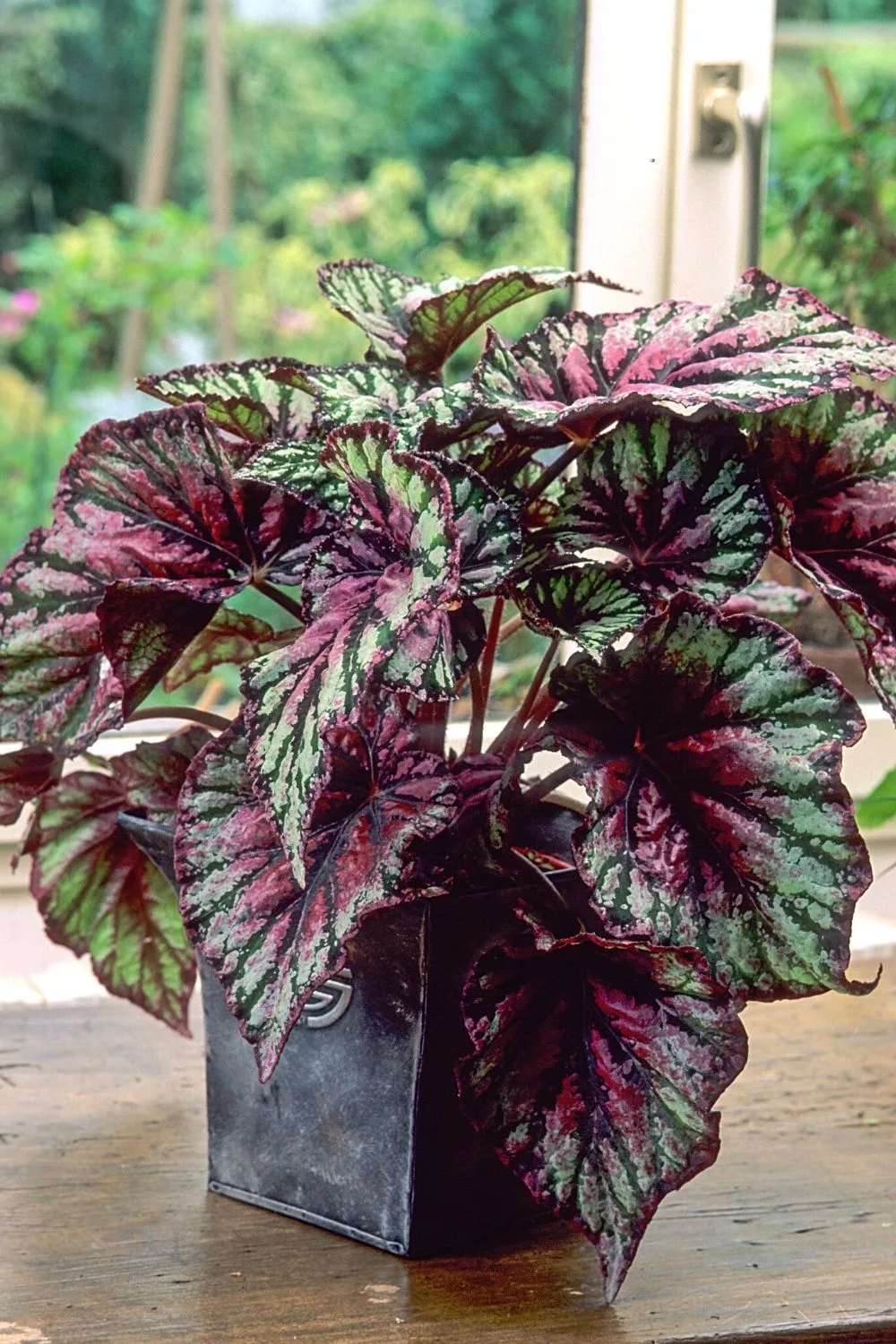
Painted Leaf Begonia, aka Rex Begonia, is easy to take care of as a potted plant placed by a northwest-facing window
This variegated plant is loved for its attractive foliage in shades of pink, burgundy, green, and silver.
The textured leaves have wavy edges, which add further drama to the plant.
This exotic-looking plant is easy to care for as a potted houseplant once you follow the care instructions.
- Family: Begoniaceae
- Scientific name: Rex Begonia
- Toxicity: Toxic for pets
- Lighting: tolerates lower light conditions compared to other Begonia varieties
- Temperature: 65-75 degrees Fahrenheit (18-24 degrees Celsius)
- Soil: well-draining soil containing perlite, vermiculite, and peat moss
- pH: between 5.7 – 6.2
- Fertilizer: use a liquid fertilizer every two weeks in the growing months
- Growth rate: moderate
- Humidity: prefers high humidity levels
19. Philodendron Imperial Red
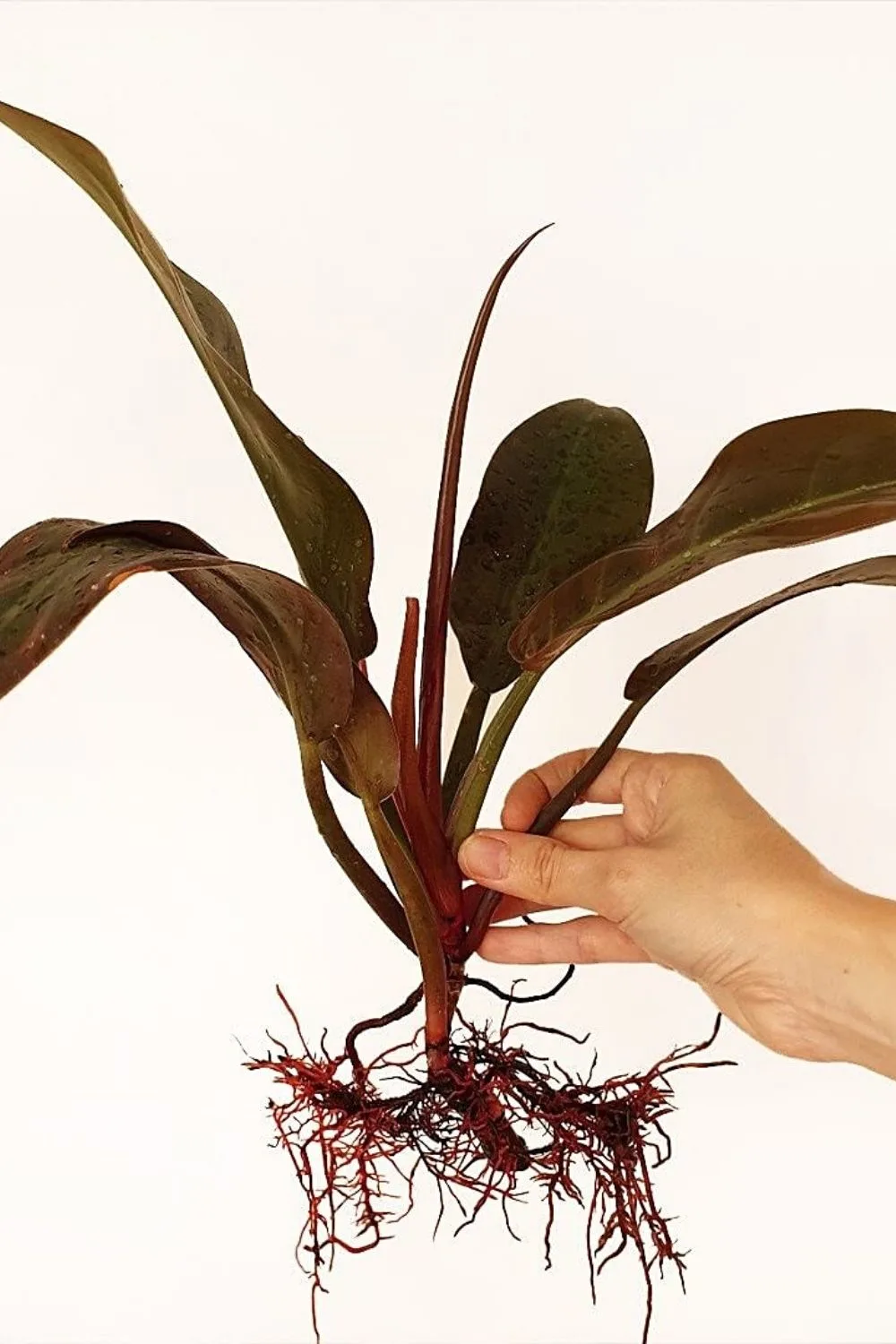
Photo Credit: @pinkthumb on Instagram!
The young leaves on this Philodendron Imperial Red, a hybrid plant, are red-colored and transform into dark green as the plant matures.
The thick petiole or stalks are bright pink or burgundy colored. This rare houseplant is a self-heading variety.
- Family: Araceae
- Scientific name: Philodendron Erubescens ‘Imperial Red’
- Toxicity: poisonous for humans and animals
- Lighting: moderate amount of filtered sunlight
- Temperature: 18-25 degrees Celsius (65-78 degrees Fahrenheit)
- Soil: needs porous soil with coco chips, bark, perlite, and sand
- pH: between 6.0 – 6.5
- Fertilizer: balanced houseplant fertilizer once a month
- Growth rate: medium to fast-growing variety
- Humidity: medium to high humidity
20. Cast Iron Plant
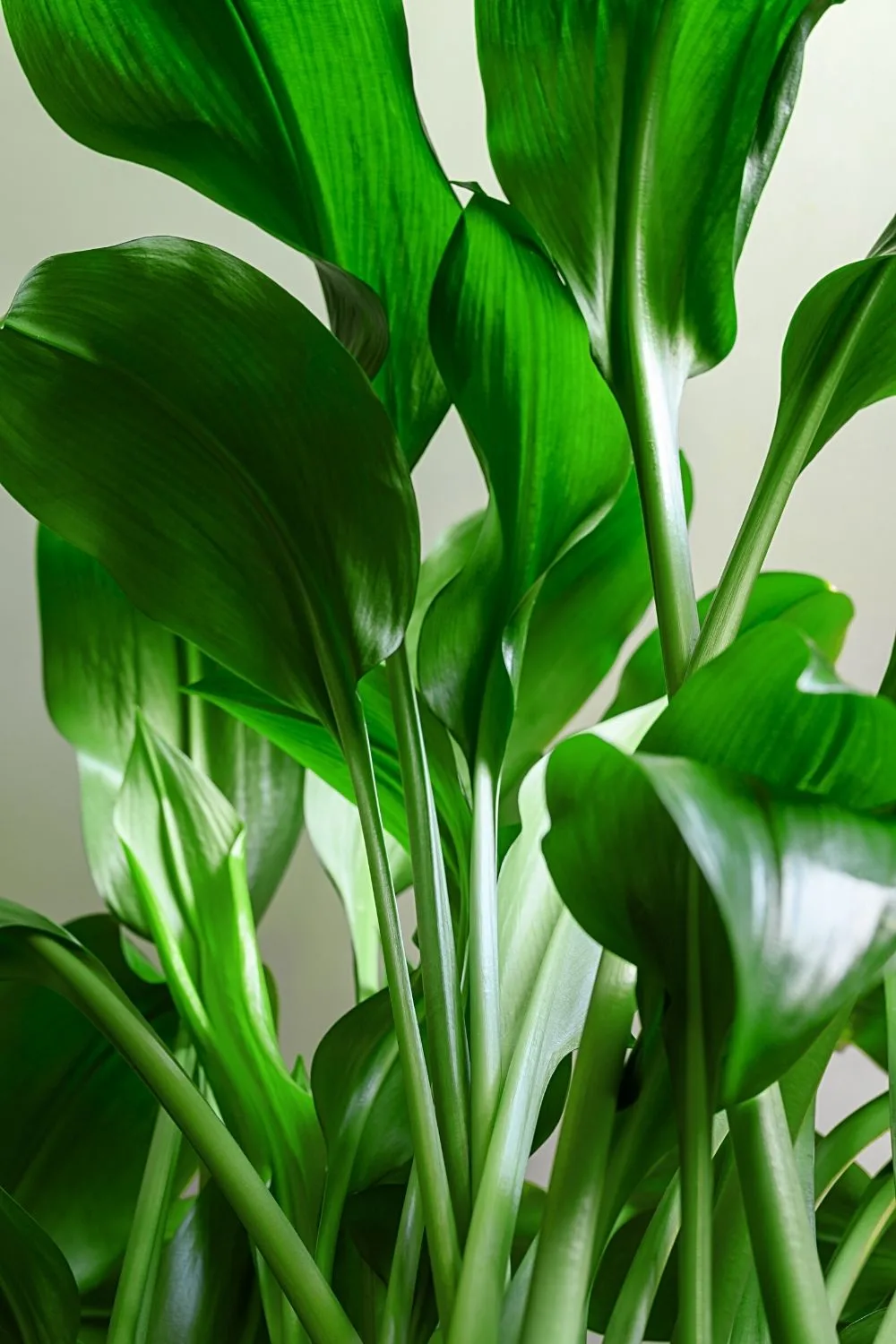
Cast Iron Plant can tolerate neglect when you occasionally forget that you placed it by your northwest-facing window
Cast Iron Plant is labeled as hard to kill since it can tolerate neglect and a variety of growing environments (including low light).
The lance-shaped foliage has a shiny look, and each of the leaves can reach a maximum length of 2 ft.
- Family: Asparagaceae
- Scientific name: Aspidistra Elatior
- Toxicity: non-toxic for pets
- Lighting: low light with no direct sunlight exposure
- Temperature: 15-22 degrees Celsius (60-73 degrees Fahrenheit)
- Soil: loamy, sand, or clayey soil mixtures
- pH: between 5.5 – 6.5
- Fertilizer: once a month with liquid plant fertilizer
- Growth rate: slow growers
- Humidity: loves high humidity
21. Sansevieria Fernwood Mikado
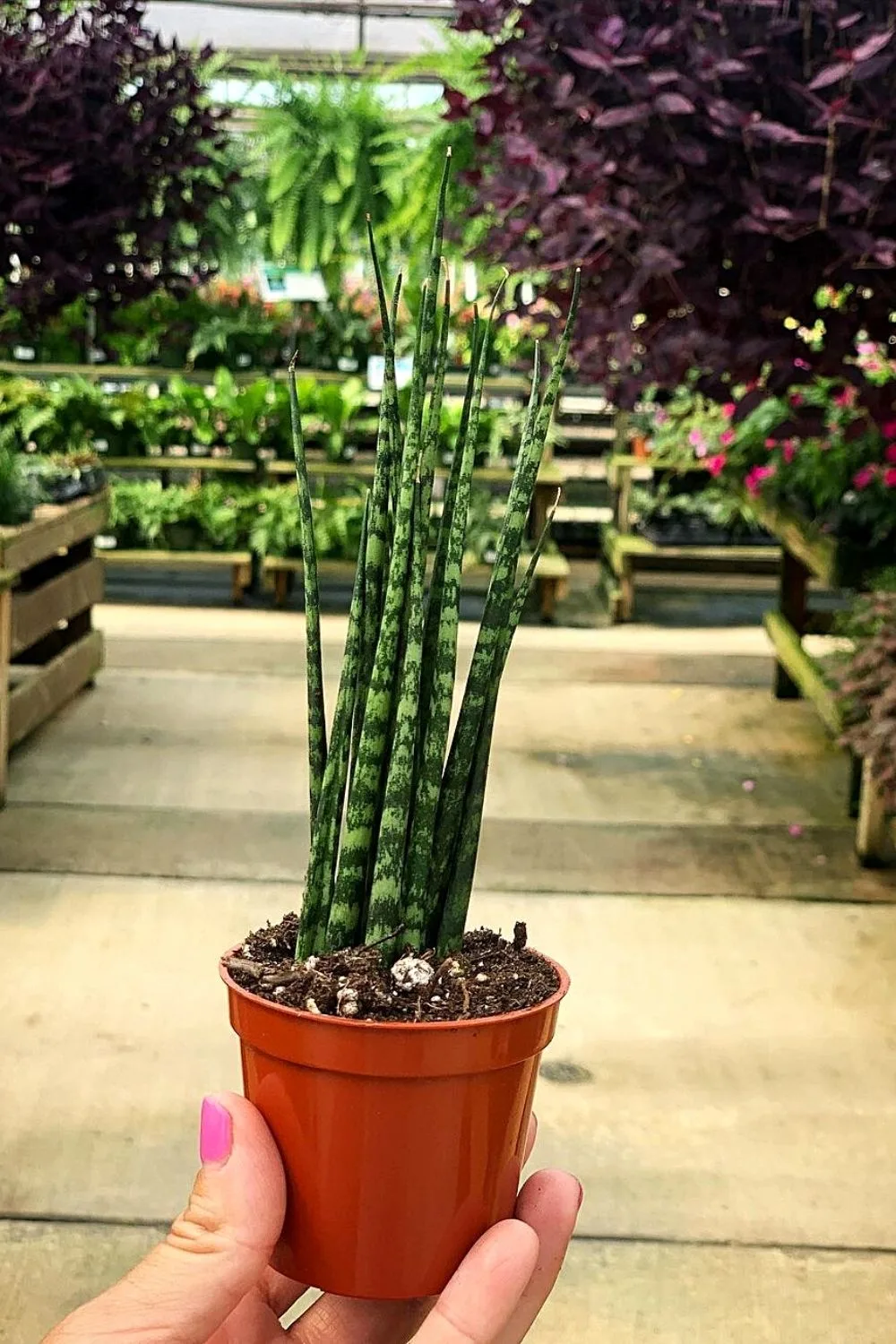
Photo Credit: @fairviewgardencenter on Instagram!
This is a hybrid version of Sansevieria Suffruticosa and Sansevieria Parva.
The cone-shaped foliage of this Snake plant features striped patterns in creamy yellow color.
This compact plant can adapt to a variety of lighting conditions. Therefore, it’s a favorite decorative plant among gardeners.
- Family: Asparagaceae
- Scientific name: Sanseveria Fernwood Mikado
- Toxicity: Mildly toxic
- Lighting: bright, filtered sunlight
- Temperature: 70-89 degrees Fahrenheit (21-31 degrees Celsius)
- Soil: Sandy soil with good drainage or cactus mix
- pH: 6.1 – 7.8
- Fertilizer: no need for feeding
- Growth rate: slow grower
- Humidity: no special humidity demands
22. Prayer Plant
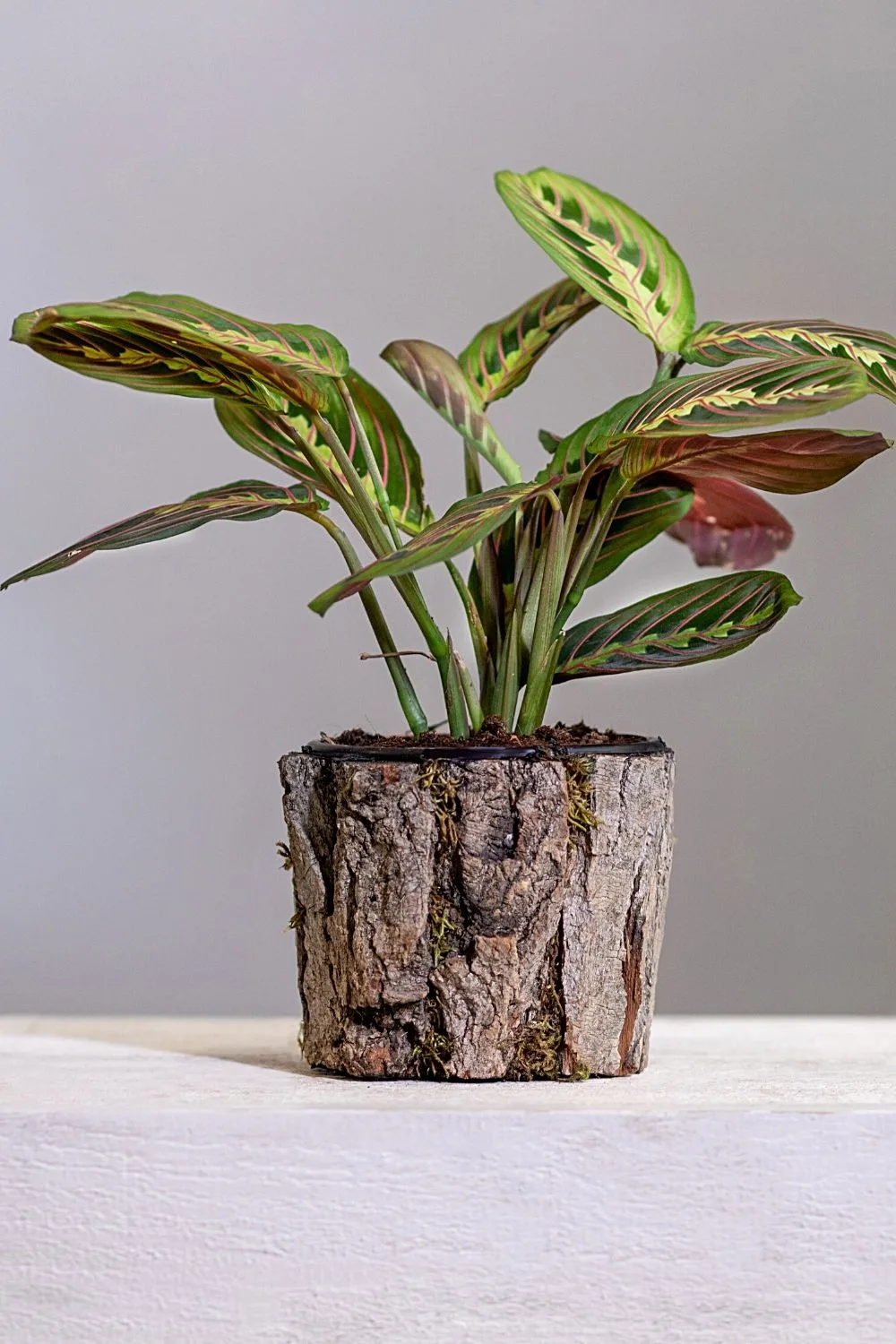
Known for its flat leaves during the play and curled leaves at night, Prayer Plant is another beautiful plant you can place by your northwest-facing window
This special plant will have flat leaves during the day and folded leaves at night, giving you dual displays in a single plant.
The decorative foliage comes in varying patterns and colors, including light green, dark green, and bright pink.
This is not an easy plant; therefore, it’s only for experienced gardeners.
- Family: Marantaceae
- Scientific name: Maranta Leuconeura
- Toxicity: non-toxic for pets
- Lighting: partially or fully shaded areas with filtered light
- Temperature: 60-80 degrees Fahrenheit (15-26 degrees Celsius)
- Soil: peat moss, loamy soil, and perlite
- pH: 5.5 – 6.0
- Fertilizer: loves extra plant nutrients; feed every two weeks in the growing season and once a month at other times
- Growth rate: slow-growing perennial
- Humidity: loves high humidity (50% or higher)
23. English Ivy
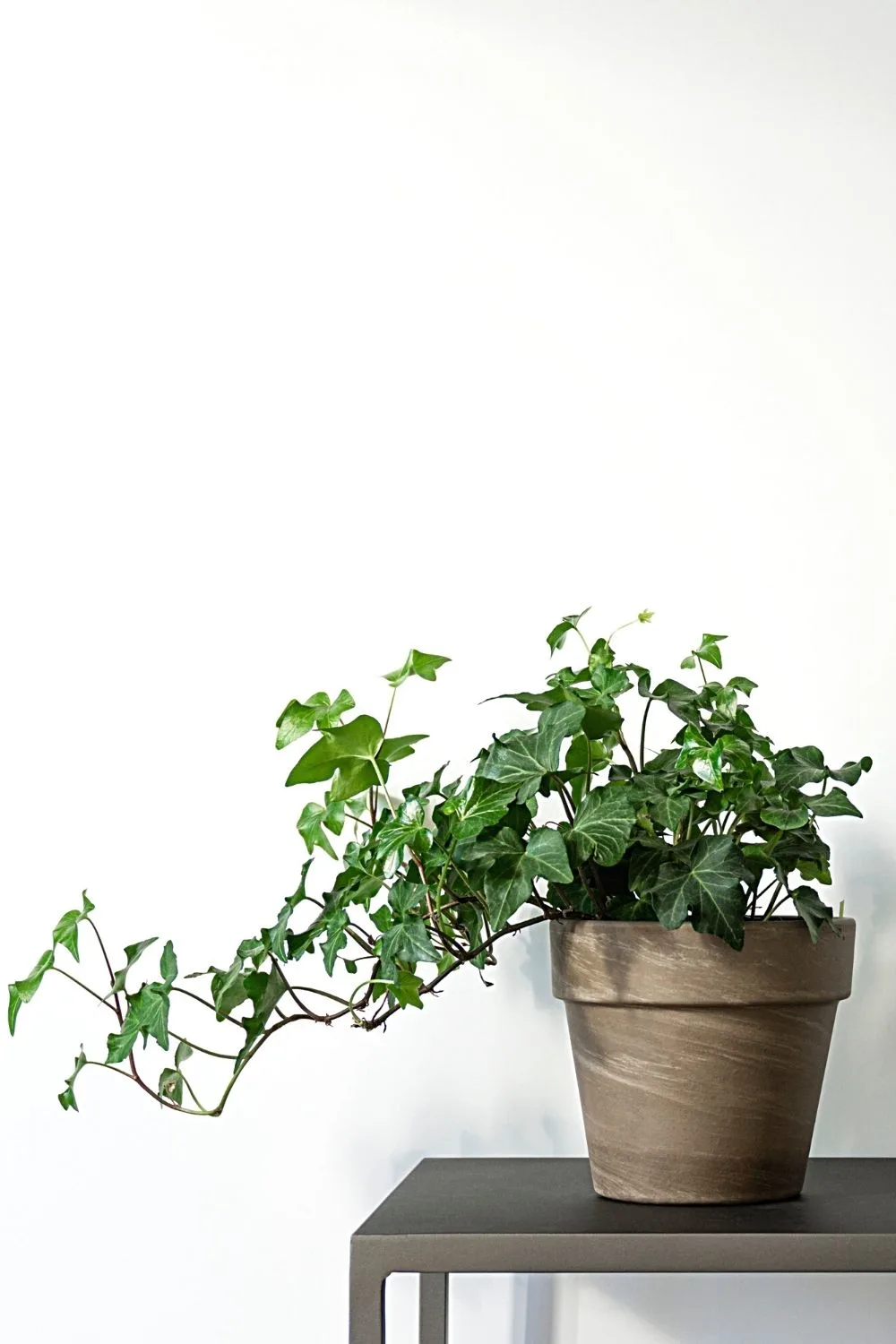
English Ivy can tolerate low-light level areas like northwest-facing windows
Otherwise known as the Common Ivy, this climbing plant is a great choice for hanging baskets where the dark green vines can spread and trail downwards.
This plant appreciates growing in low light areas with cold temperatures; therefore, it can be safely grown in a northwest-facing window.
- Family: Araliaceae
- Scientific name: Hedera Helix
- Toxicity: toxic for pets and humans
- Lighting: Shaded spots with minimal light exposure
- Temperature: 65-85 degrees Fahrenheit (18-29 degrees Fahrenheit)
- Soil: a combination of well-draining potting soil, perlite, and peat moss
- pH: close to 6.5
- Fertilizer: use a complete fertilizer every two weeks in summer and spring
- Growth rate: fast grower and invasive
- Humidity: 40% or higher
24. ZZ Plant
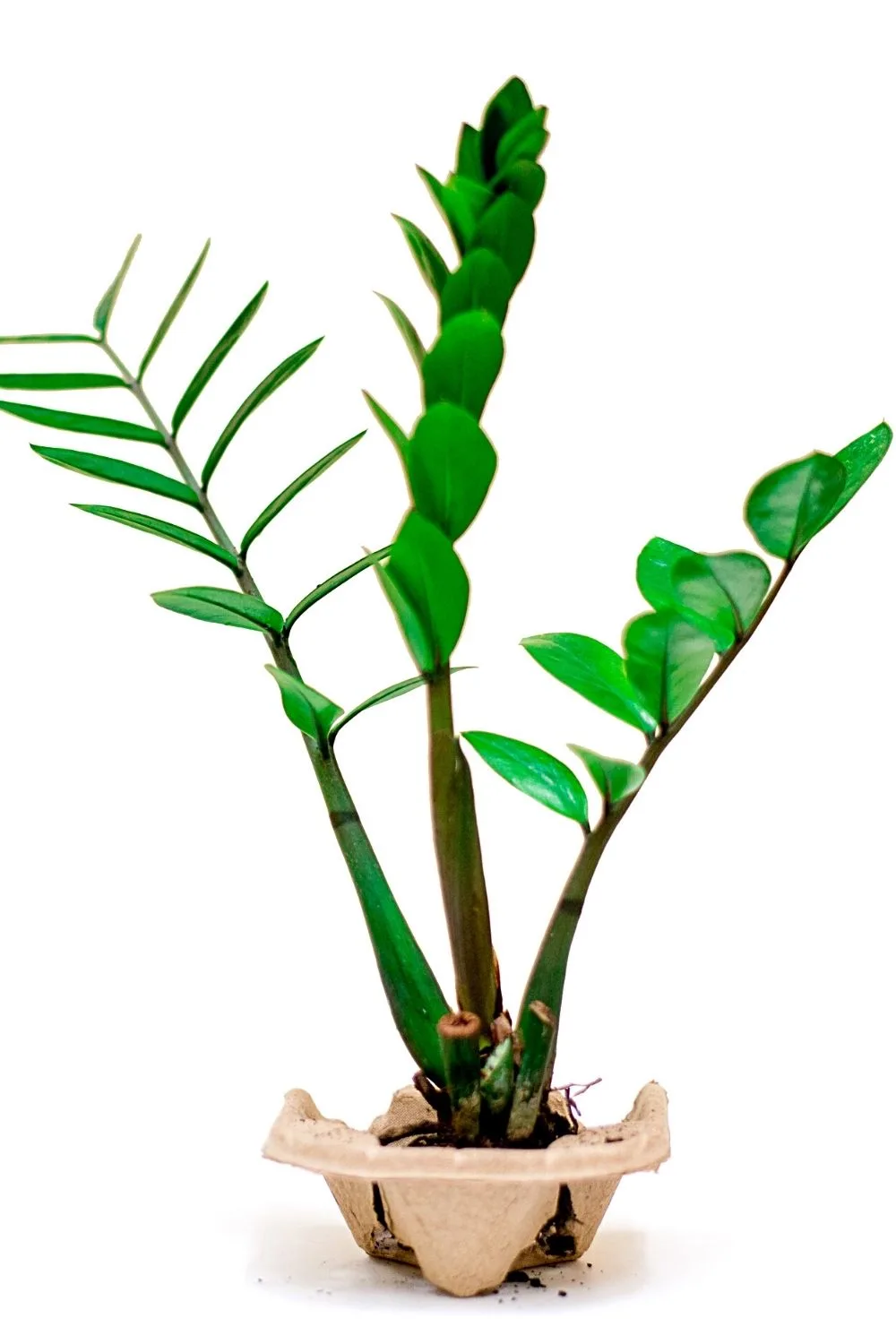
ZZ Plant thrives in areas receiving minimal light as in the case of a northwest-facing window
The classic dark green foliage, low light, and drought tolerance make the ZZ plant a popular choice for gardeners with minimal sunlight.
- Family: Araceae
- Scientific name: Zamioculcas Zamiifolia
- Toxicity: All parts of the plant are poisonous to humans and pets
- Lighting: low light or bright, indirect light
- Temperature: 65-84 degrees Fahrenheit (18-29 degrees Celsius)
- Soil: well-draining soil mix which contains perlite and sand
- pH: 6.0 – 7.0
- Fertilizer: Apply liquid fertilizer once a month during the active growth period
- Growth rate: slow-growing variety
- Humidity: loves high humidity
25. Rattlesnake Plant
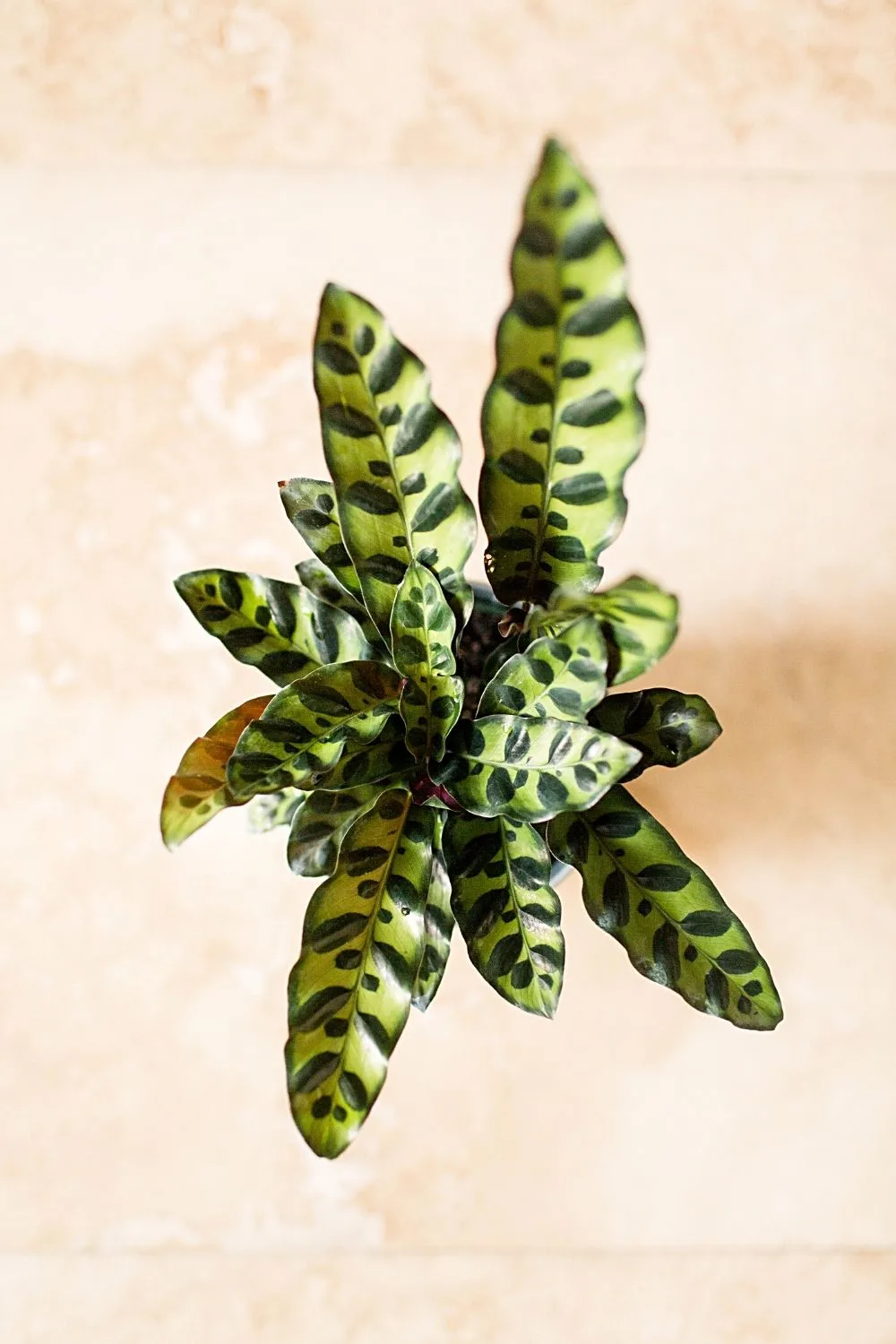
Rattlesnake Plant is a low-light plant that you can place by your northwest-facing window
Rattlesnake Plant is one of the interesting-looking, low-light plants on this list with its dark and light green leaves and marble pattern.
It loves indirect sunlight throughout the day, and too much light can give a discolored look to the foliage.
This plant will thrive in a northwest-facing window of the kitchen or bathroom where it receives low levels of sunlight but high humidity.
- Family: Marantaceae
- Scientific name: Calathea lancifolia
- Toxicity: nontoxic
- Lighting: Avoid direct sunlight as it tolerates bright, filtered light
- Temperature: 70-85 degrees Fahrenheit (21-29 degrees Celsius)
- Soil: peat-based or African violet potting mixture
- pH: slightly acidic soil
- Fertilizer: once a month in the spring to fall seasons
- Growth rate: slow-growing under low light
- Humidity: needs a humid environment to replicate the natural growing conditions
26. Silver Pothos

Silver Pothos, with its variegated leaves of white and green, is another great plant to place by your northwest-facing window
Silver Pothos is just like the regular Pothos, except that it has variegated leaves in shades of silver and green.
This is a great plant for indoors because it’s not cold hardy and needs protection from harsh weather.
- Family: Araceae
- Scientific name: Scindapsus Pictus
- Toxicity: not pet friendly
- Lighting: prefers bright, indirect sunlight
- Temperature: 65-84 degrees Fahrenheit (18-29 degrees Celsius)
- Soil: use a well-draining potting mix or prepare your soil using peat, perlite, and bark
- pH: 6.1-6.5
- Fertilizer: only once a month from spring until fall
- Growth rate: Slow to moderate growth
- Humidity: 40-50%
27. Kentia Palm
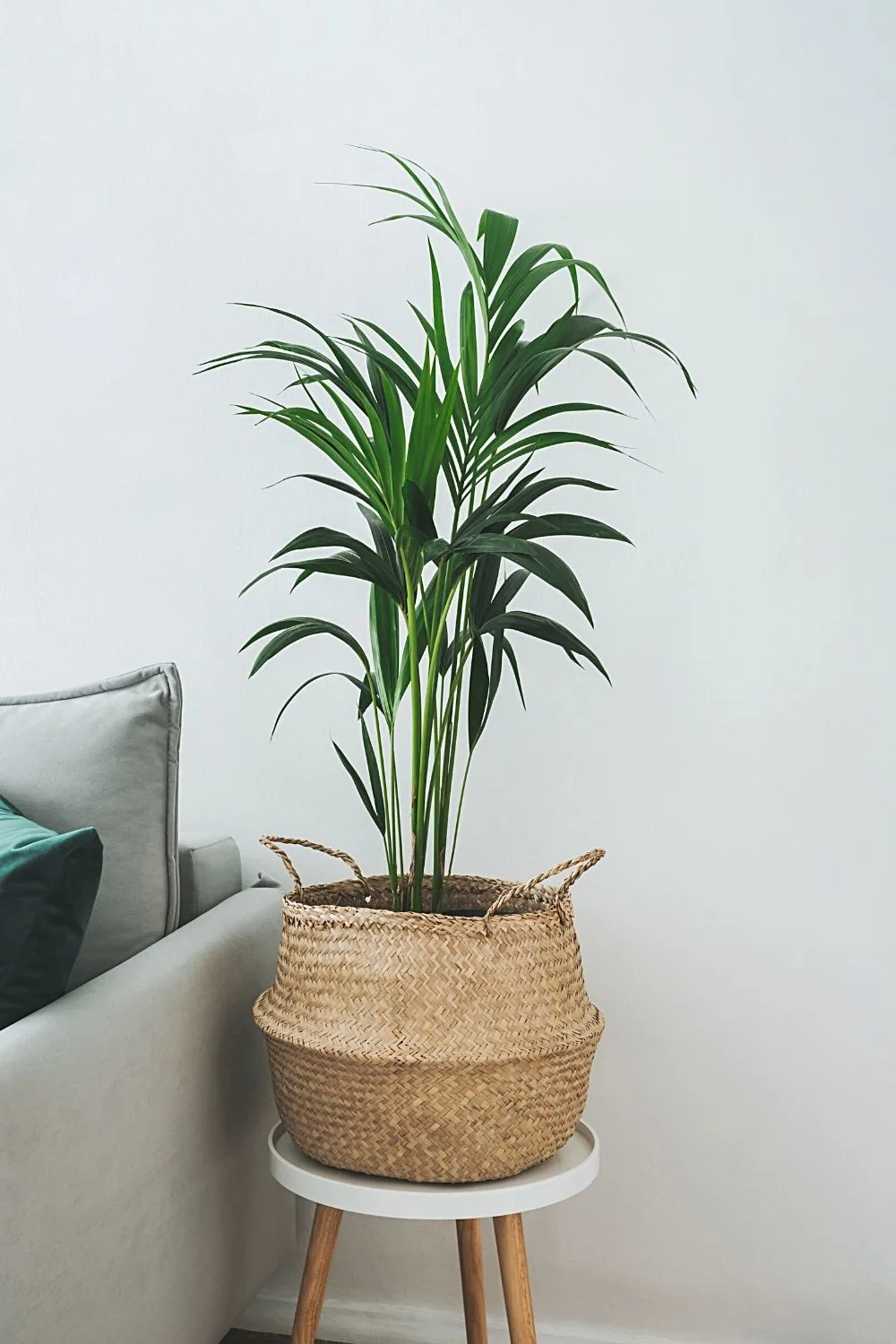
Another low-light thriving plant that you can place by your northwest-facing window is the Kentia Palm
Kentia Palm is a highly recommended palm variety for indoor spaces since it is low-light tolerant. It can also handle cold and will not take over the growing space.
It reaches a mature height of 12 ft as a potted indoor plant with its pointy lush green palm leaves.
- Family: Arecaceae
- Scientific name: Howea Forsteriana
- Toxicity: pet-friendly palm variety
- Lighting: prefers shady locations
- Temperature: warm temperatures between 18-22 degrees Celsius (65-73 degrees Fahrenheit)
- Soil: clayey or sandy soil mixture with excellent drainage
- pH: 6.0 – 8.0
- Fertilizer: only once a month with liquid fertilizer
- Growth rate: slow-growing
- Humidity: high humidity will keep the leaves happy and thriving
28. Moth Orchid
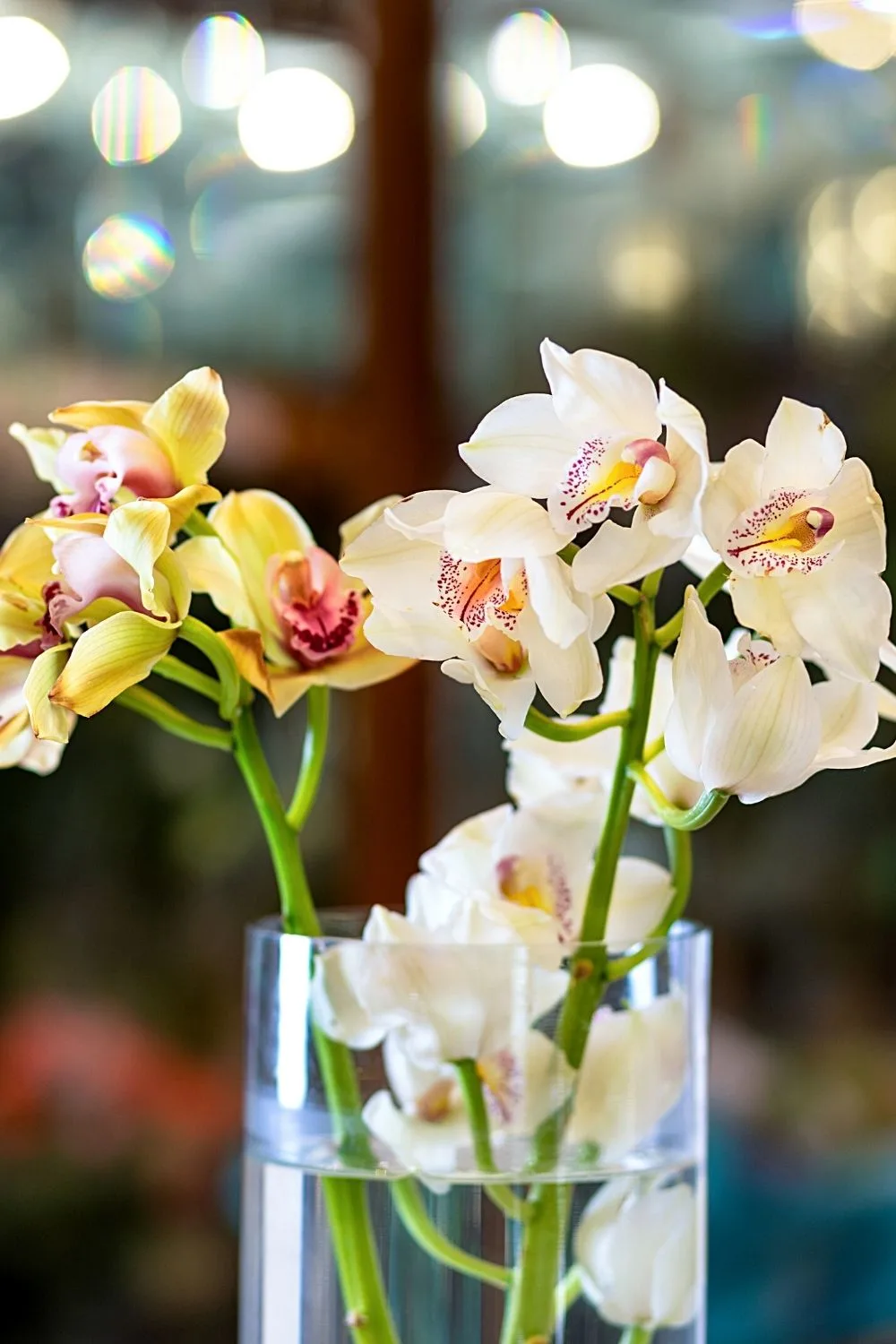
Moth Orchid is a great beauty to add to your northwest-facing window
The bright pink or pastel flowers on this variety will give a gorgeous but minimalist look to your window garden.
It thrives in several light conditions, including low or filtered sunlight. Make sure you water it every one or two weeks so that it blooms all year.
- Family: Orchidaceae
- Scientific name: Phalaenopsis Blume
- Toxicity: non-toxic for pets
- Lighting: needs a bright but shaded spot
- Temperature: 75-84 degrees Fahrenheit (24-28 degrees Celsius)
- Soil: moist growing medium with bark chips
- pH: 5.5 – 6.5
- Fertilizer: use orchid fertilizer once a month
- Growth rate: slow-growing
- Humidity: close to 80%
29. Hoya Wayetii
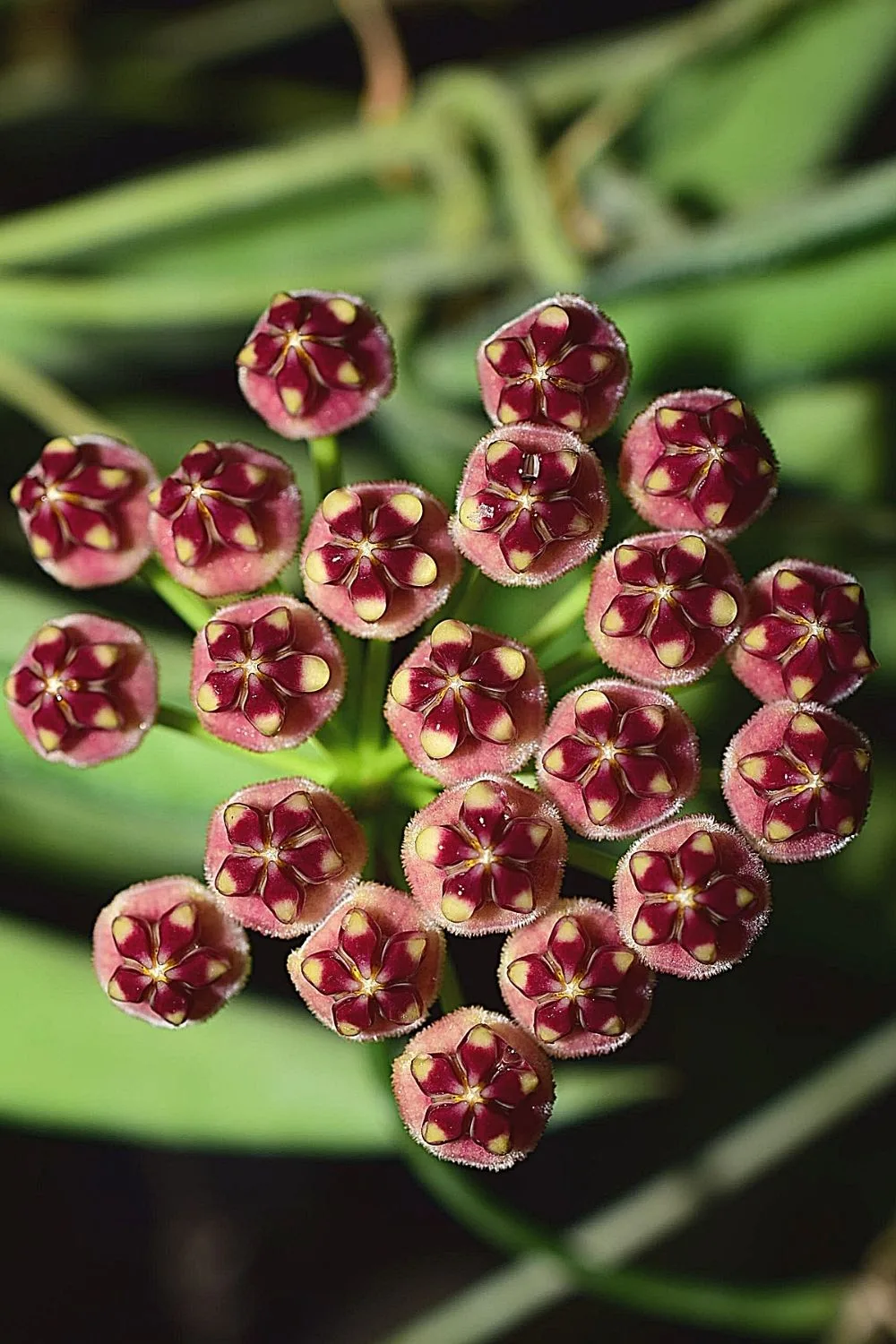
Hoya Wayetii is a plant coming from the Philippines that’s great to place indoors, preferably by a northwest-facing window
The long pointy green leaves with dark edges make this plant different from other Hoyas.
Hoya Wayetii belongs to the Philippines and produces clusters of flowers even when planted indoors.
- Family: Apocynaceae
- Scientific name: H. Wayetii
- Toxicity: safe for pets
- Lighting: bright, indirect sunlight
- Temperature: 60-85 degrees Fahrenheit (15-29 degrees Celsius)
- Soil: potting soil mixed with perlite and bark
- pH: slightly acidic or neutral
- Fertilizer: 2-3 feedings per month
- Growth rate: slow grower
- Humidity: between 60-80%
30. Porcelain Flower
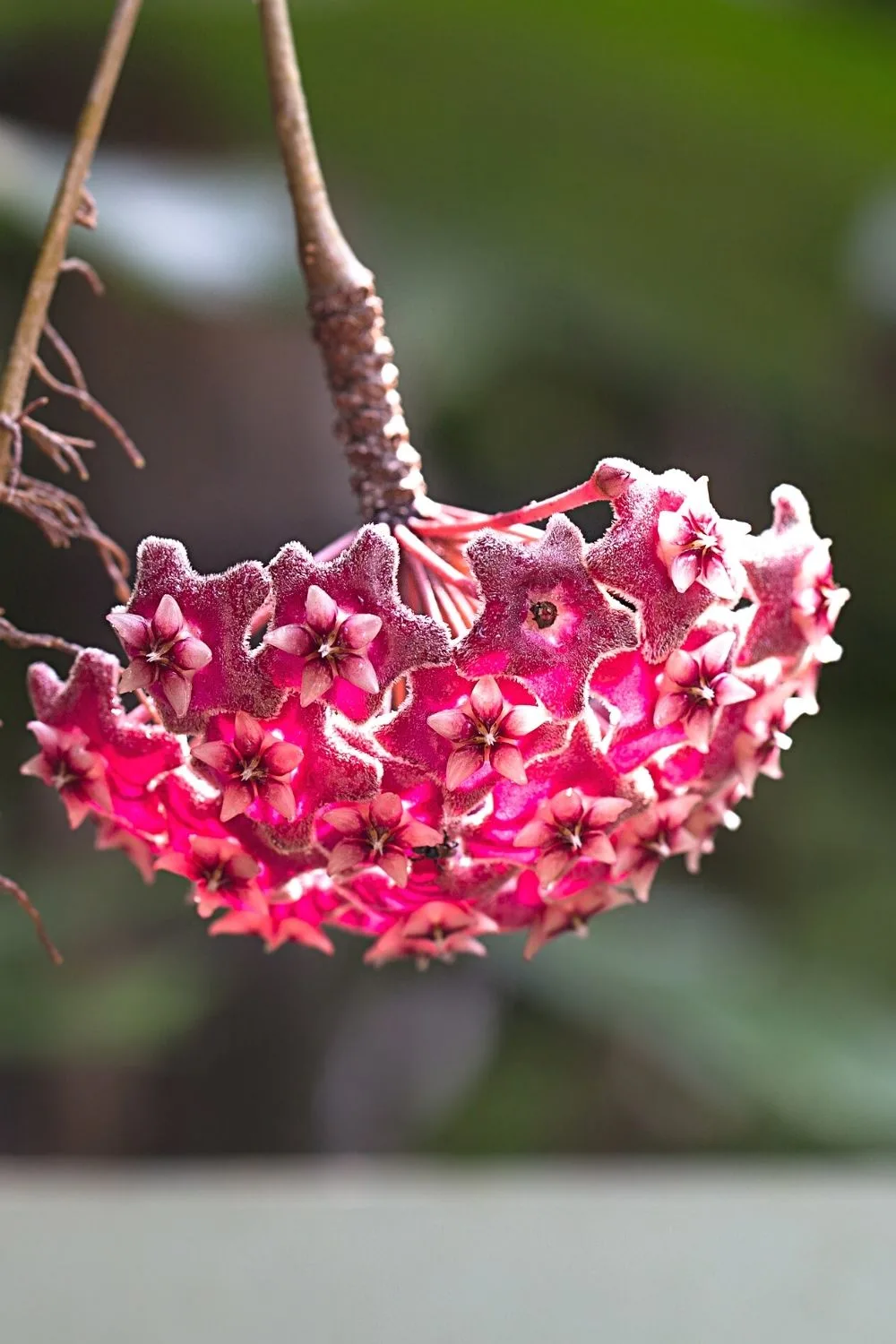
The pink blossoms of the Porcelain Flower is a great addition to your northwest-facing window
This low-maintenance Hoya variety has deep green leaves and pink-colored, scented blooms.
It has multiple variants, and you should grow it in a hanging basket to optimize the beauty of the flowers and foliage.
- Family: Apocynaceae or dogbane
- Scientific name: Hoya Pubicalyx
- Toxicity: mildly toxic if consumed by pets or humans
- Lighting: tolerates medium to bright, filtered light (6 hours of light each day)
- Temperature: 60-74 degrees Fahrenheit (15-23 degrees Celsius)
- Soil: use orchid bark, peat moss, and perlite to create a soil mixture that’s well-draining
- pH: 6.5 – 7.5
- Fertilizer: does not require heavy feeding
- Growth rate: fast-growing variety
- Humidity: 60% or higher
Conclusion About Plants for Northwest Facing Windows
To conclude, northwest-facing windows will get a steady supply of natural light throughout the day; therefore, you should consider placing the plants that cannot withstand fluctuating light levels.
The low light levels will also impact the temperature levels of the room.
Keep in mind that windows with less light will have lower temperatures with a risk of drafts during the winter months.
You should also clean the leaves regularly to make sure the foliage can receive the right amount of sunlight.

Daniel has been a plant enthusiast for over 20 years. He owns hundreds of houseplants and prepares for the chili growing seasons yearly with great anticipation. His favorite plants are plant species in the Araceae family, such as Monstera, Philodendron, and Anthurium. He also loves gardening and is growing hot peppers, tomatoes, and many more vegetables.


